Counterfeit Christmas Cards
by SGM Herbert A. Friedman (Ret.)
NOTE: this article has a Table of Contents at the end
This article is reproduced on the MPHS website with the permission and assistance of its author, Herbert A. Friedman.
Ownership of the article is his alone.
The original article is located on "psywarrior.com"
Note: A modified version of this article appeared in the December 2002 issue of the American Philatelic Society Journal. The entire story appears here. The Filipino website FilipiKnow used images from this article in a story entitled “9 Fascinating Facts You didn't Know About Christmas in the Philippines.” The Weekly Pegasus, The newsletter of professional readings of the U.S. Air Force Military Information Support Operations Working Group recommended this article in their 23 December 2017 issue. The Philippine Diary Project requested the use of an image from this story to illustrate a Christmas card mentioned by prisoner-of-war Albert E. Holland, on 25 December 1944.
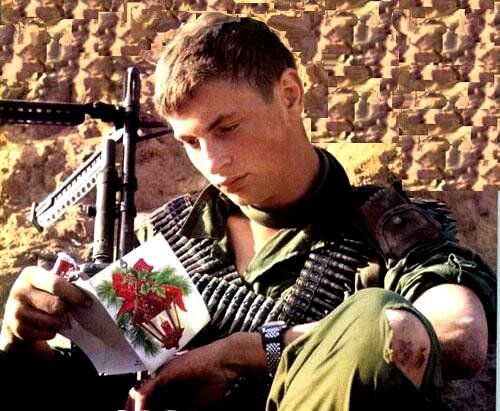
For many Americans, the Christmas season is their favorite time of the year. This is especially true of those in military service, far from home and their loved ones. Visions of Christmas trees, holly, mistletoe, and snow-covered landscapes bring back pleasant memories of their youth and happy carefree days. Our enemies are aware of this sentimental trait. For over 50 years they have prepared fake Christmas cards that featured those wonderful holiday images as propaganda in an attempt to demoralize the American soldier, make him homesick, and cause him to consider surrender. This is a wonderful and very rare field of study and I thought our readers might be interested in seeing what our enemies have done in this area since World War II.
World War II

A 1944 painting is of a WWII Marine taking a break
from playing Santa Claus and delivering gifts to the troops.
Japan
The Japanese produced at least seven different Christmas cards to be used against U.S. forces on Guadalcanal in December of 1942. The text is in English. Some of these cards are described in the Japanese-language book Paper War, published by the Preservation Society of the Peace Museum. I should point out that the first four cards are in the form of "Vargas girls" pinup posters, so GIs would be likely to collect them as much for the pictures of the girls as for the Christmas sentiments. The last few cards are classic Christmas scenes and could have been found on any Hallmark greeting card.
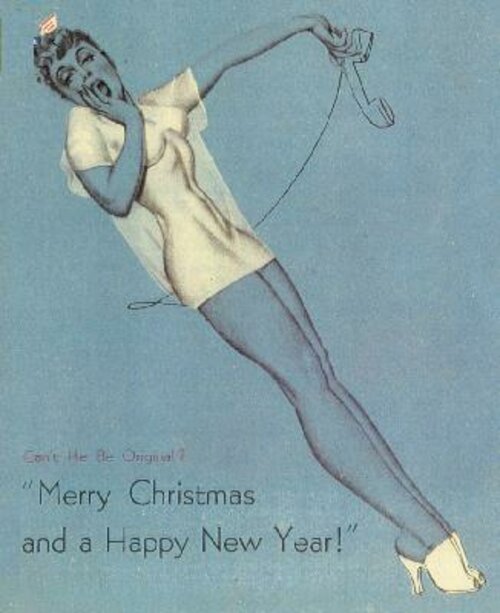
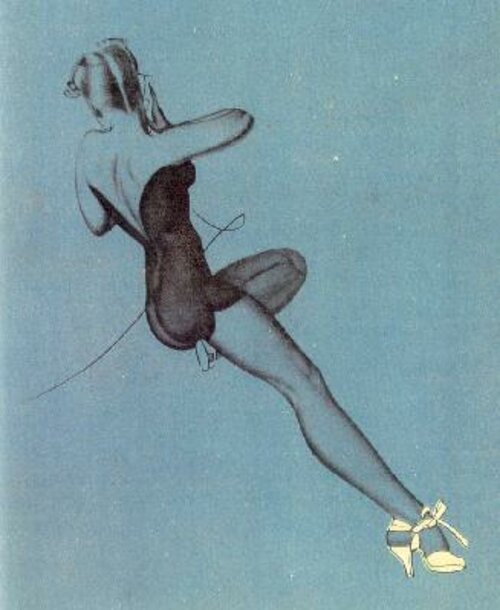
1. This card is on blue paper and depicts a pinup drawing of a girl in a transparent white negligee talking on a telephone. Text on the front says "Can't he be original? Merry Christmas and a Happy New Year." The back of the card shows a similar picture of a girl in a black negligee. When opened, the card has a long handwritten note to "Dearest Jim," which starts "Another day passes without word from you and I write wondering whether this will reach you or not. Why, oh why don't I hear from you…?” The letter is signed "Love and kisses, Claire."
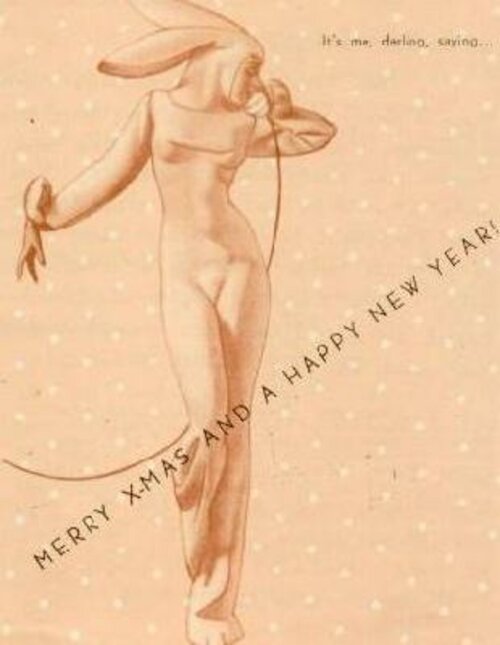
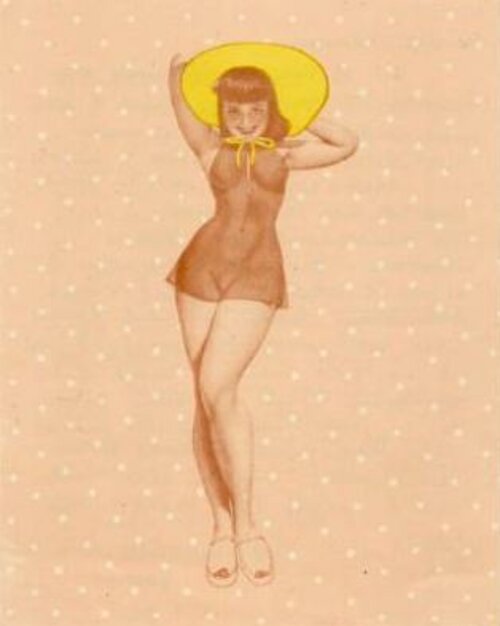
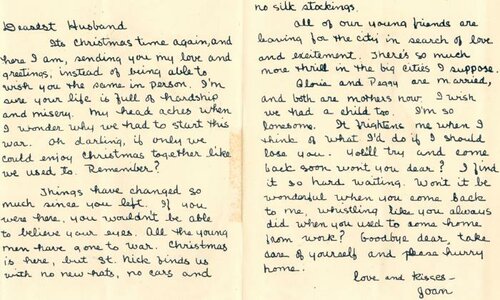
2. The front of this beige-colored card depicts a pinup of a girl in a bunny suit talking on a telephone. The text reads, "It's me, darling, saying…Merry Christmas and a Happy New Year." The back shows a girl in a transparent summer outfit with a wide-brimmed hat. The hand-written letter inside begins "Dearest husband, It's Christmas time again and here I am, sending you my love and greetings, instead of being able to wish you the same in person. I'm sure your life is full of hardship and misery. My head aches when I wonder why we had to start this war…" and ends "Love and kisses, Joan."
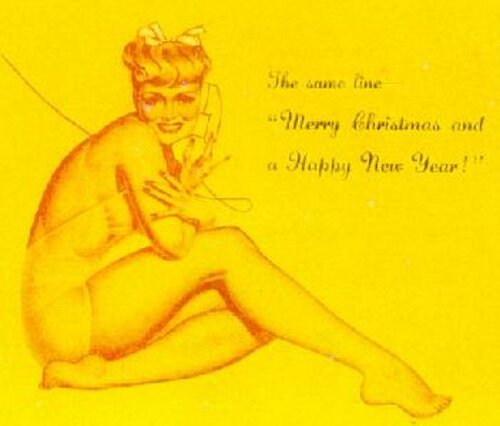
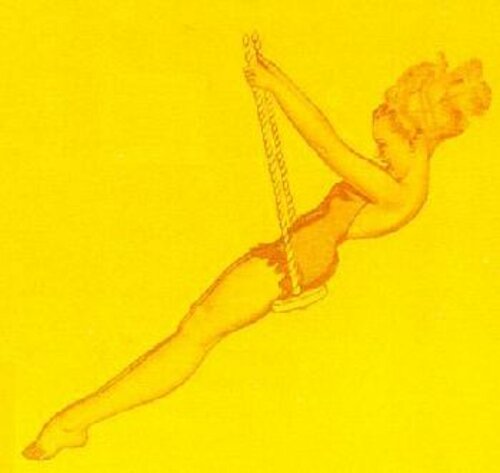
3. This bright yellow card features, in the front, a girl in a bathing suit talking on a telephone. The text is "The same line – Merry Christmas and a Happy New Year." The back shows a girl in a bathing suit on a swing. The text begins "My dearest darling. They promised us that the war would be over by autumn and so I could see you by Christmas, but their promise hasn't come true. They make all sorts of promises, these politicians, but it all just so much air!! When will the war end? It seems like it'll go on and on forever…" and ends, "With love and kisses, Lorraine."
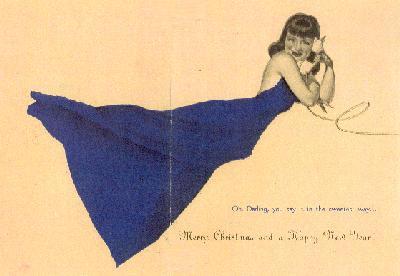
4. A girl in a beautiful formal black dress reclines across both the front and back of this beige-colored card. Text on the front reads "Oh, Darling, you say it in the sweetest way…Merry Christmas and a Happy New Year!" The text inside begins "Dearest Darling, it was rumored that this awful war would end by Christmas last year. We all hoped that the rumor would come true, but Christmas is here again and peace seems as far away as ever, and I feel so lonely and so despondent…" and ends, "With love, Nancy." This card was first illustrated in Psychological Warfare, Paul Linebarger, Combat Forces Press, Washington DC, 1954. Linebarger treats this propaganda as sexual in nature and ignores the Christmas connection. He says, "Young human beings, especially young males, are apt to give considerable attention to sex. In areas of military operations, they are removed from the stimuli of secondary sex references, which are (in America) an accepted part of everyone's daily life: bathing beauty photos, magazine covers, semi-nudes in advertisements, etc. Our enemies tried to use the resulting pin-up craze for propaganda purposes, hoping that a vain arousal of oestrum would diminish morale." Linebarger states that this leaflet was used in the Philippines, so it might have been dropped more than once.

5. This is the first of the more traditional cards. The front shows "Greetings!" with a candelabrum and a picture window through which we see a snowy Christmas scene. Inside on the left: "He that oppresseth the poor and just to increase his riches, and he that giveth to the rich, shall surely come to want. Proverbs 22. 16." Inside on the right: "The question on which strikes at the heart of the war situation like a dagger is not: who caused the war? It is not even: who brought America into the war? The revealing question is: who profited by the war, pocketed the profit and defends the profit? The major portion of the war profits goes into the hands of the wealthiest families of America. (by) Frederick Wiehl, President of the All-American Association. But whether or not these plutocrats will come to want is another question."
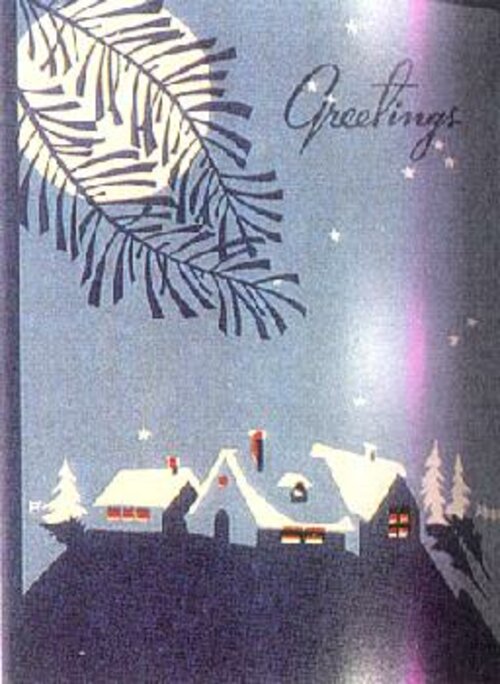
6. The front of this blue-colored card shows "Greetings", with three homes with snowy roofs and a bright moon above. Inside on the left is the same verse from Proverbs 22.16 as in the preceding card. Inside on the right: "The capitalists that oppress the poor to increase their riches, and the government that helpth (sic) the rich in waging this war shall surely come to grief."
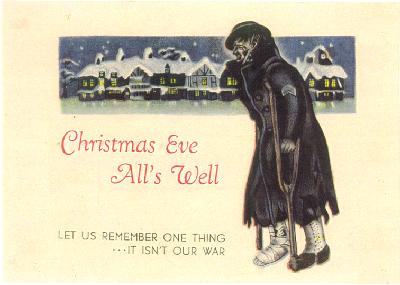
7. There is another Christmas card leaflet printed only on the front of a single page. The leaflet is 128 x 90 mm in size. The card shows an American corporal in a tattered overcoat walking with crutches. His right leg is heavily bandaged. Behind him there is a nighttime holiday scene of snow-covered homes beneath a starry sky. The text on this leaflet is "Christmas Eve - All's well - Let us remember one thing...it isn't our war." The back is blank.
The Japanese used a Christmas card motif on their propaganda again in December of 1944 during the American liberation of the Philippines. Five cards are known at present.
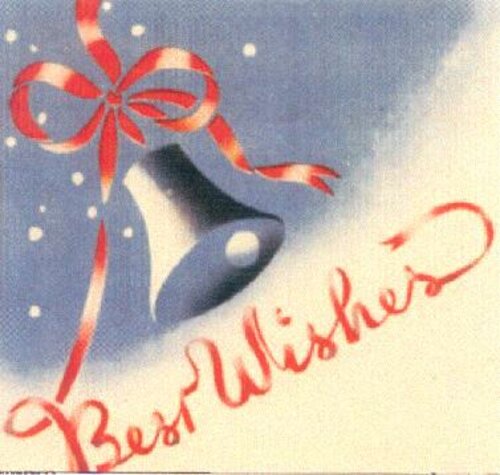
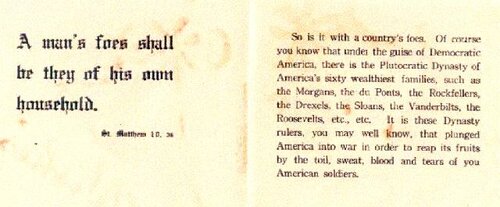
1. A Christmas card with blue bell and red ribbon formed into "Best Wishes" on front, and three bells on back. The card opens to reveal a biblical quote on the left from Matthew 10:36, "A man's foes shall be they of his own household", and an anti-American message on the right, "So it is with a country's foes. Of course you know that under the guise of Democratic America, there is a Plutocratic Dynasty of America's sixty wealthiest families, such as the Morgans, the du Ponts, the Rockefellers, the Drexels, the Sloans, the Vanderbilts, the Roosevelts etc., etc. It is these dynasty rulers, you may well know, that plunged America into war in order to reap its fruits by the toil, sweat, blood and tears of you American soldiers."
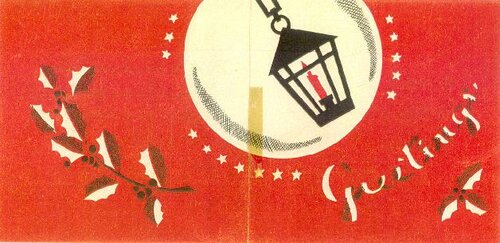

2. A Christmas card on red paper with a candle lantern and "Greetings" on the front, holly and stars on the back. The card opens to reveal the same biblical quote from Matthew 10:36 at left, "A man's foes shall be they of his own household." An anti-American message on the right states, "Your foes are they of your own country – American Big Business which is driving you to the gigantic slaughter-house the world has ever known."
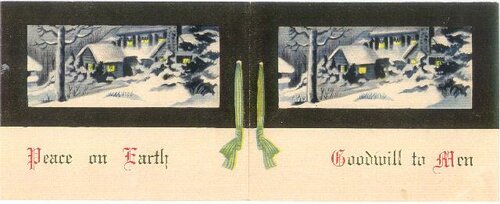
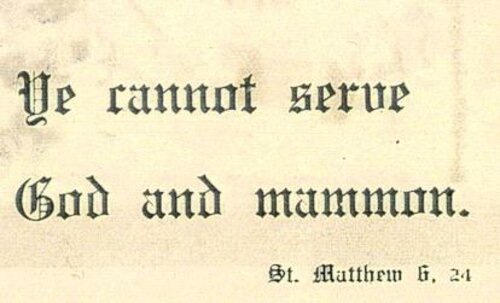
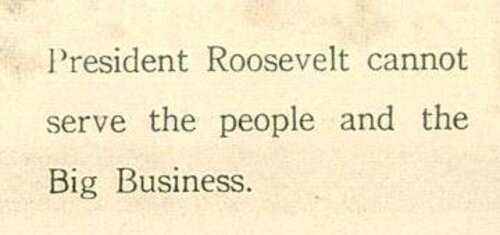
3. A Christmas card with an identical vignette on each side showing an outdoor scene of a house covered with snow. The text "Goodwill to Men" is on one side and "Peace on Earth" is on the other. The card opens to reveal a biblical quote at left "Ye cannot serve God and mammon. St. Matthew 6. 24," and on the right, "President Roosevelt cannot serve the people and the Big Business."
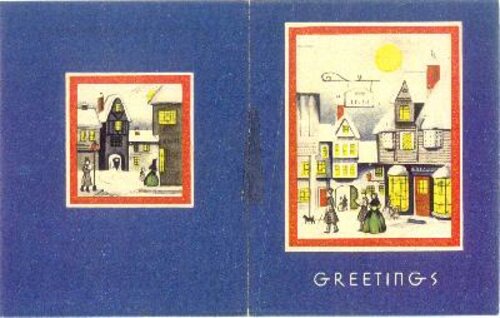

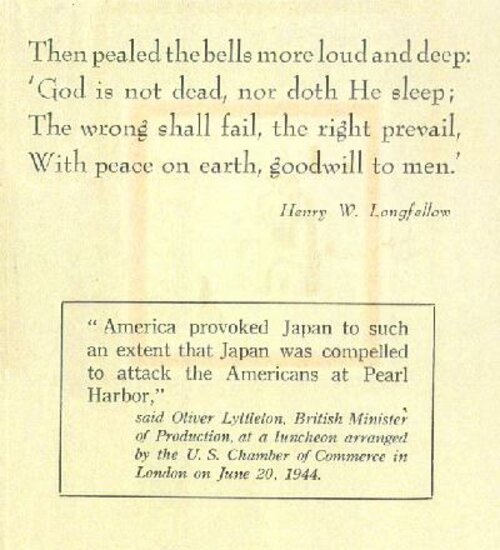
4. A Christmas card with a large English town scene in the style of Currier and Ives on the front with the text "Greetings," and a smaller similar scene on the back. The card opens to reveal the full text of the Henry W. Longfellow poem "I Heard the Bells on Christmas Day," and a boxed anti-American quotation, "America provoked Japan to such an extent that Japan was compelled to attack the Americans at Pearl Harbor." Oliver Lyttleton, British Minister of Production allegedly made the comment at a luncheon arranged by the U.S. Chamber of Commerce in London on June 20, 1944.
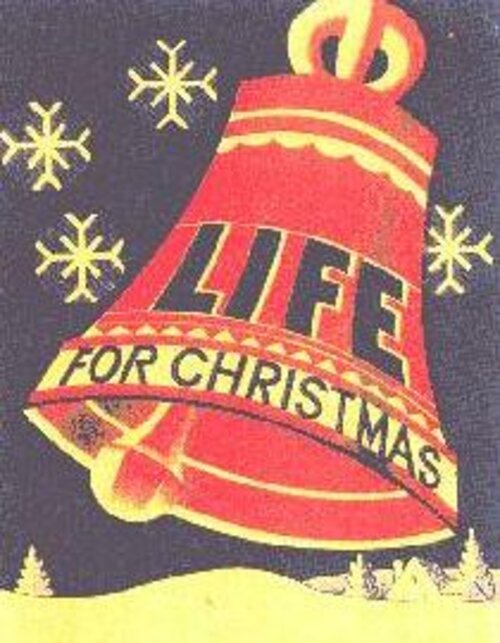
5. A Christmas card with a large red bell with the text "LIFE for Christmas" on the cover. The card opens to reveal the text:
"HERE's ALL YOU DO!"
1. Come towards are lines waiving a white flag!
2. Strap your gun over your left shoulder , muzzle down and pointedbehind you.
3. Show this ticket to the sentry.
4. Any number of you may surrender with this ticket.
Japanese Army Headquarters.
The Japanese produced numerous other propaganda leaflets with similar scenes and messages, but we have only described those that actually are in the form of the traditional Christmas card.
The United States
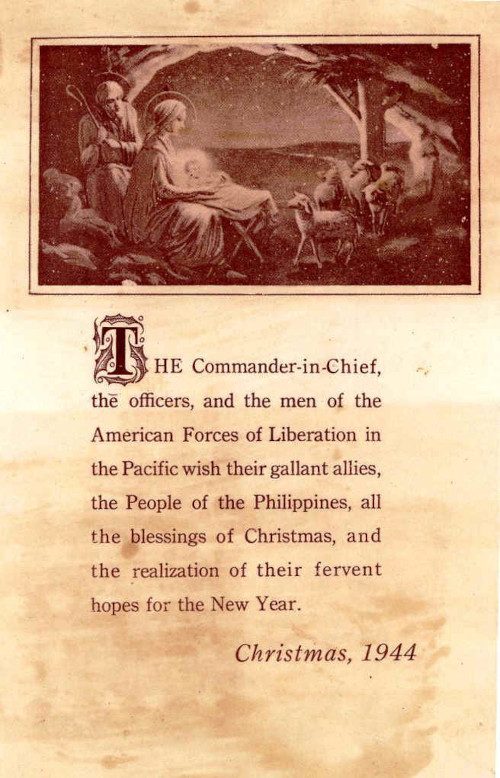
Christmas 1944
The United Sates did not produce many propaganda items that featured Christmas as the major theme. Such leaflets would not have been efficient against a nation with a Christian minority like Japan. The Philippine Islands under Japanese occupation was a Christian country, so a propaganda leaflet in the form of a Christmas card was distributed there. The leaflet has an illustration of the Virgin Mary and baby Jesus in a manger at the top. The entire leaflet is in various shades of brown.
The Commander in Chief, the officers and men of the American Forces of Liberation in the Pacific wish their gallant allies, the people of the Philippines, all the blessings of Christmas, and the realization of their fervent hopes for the New Year. Christmas 1944.
Notice the discoloration on this leaflet. Because it was used in the Philippines it was probably produced by General MacArthur’s Psychological Warfare Branch. It does not bear a code number (usually a numerical with the letter “J”) because I suspect it was meant as a religious and not a political message. The PWB members often kept souvenir books with the leaflets they printed. This one appears to have been glued down and then soaked in water to remove it from the page. I believe the stains are old glue marks.
The Philippine Diary Project reported that an American internee at the University of Santo Tomas Internment Camp, Albert E. Holland wrote in his diary on 25 December 1944:
Dec. 25th – Our 3rd Xmas here – And a wonderful one! First Xmas Cards dropped from our planes (copy of message attached) – Then Mass & Communion – Breakfast – Then I wrote messages to friends - Dorita gave me a pair of socks & her share of the piece of chocolate. The children each gave me a cigar – Dorita fixed luncheon – Mr. Van Vorhees gave me a can of coffee & a can of spinach soup…
During the war, a total of about 7,000 people were resident in Santo Tomas. In January 1945, a doctor reported that the average loss of weight among male internees had been 53 pounds during the three years at Santo Tomas, 32.5 percent of average body weight. From January 1942 until March 1945, 390 total deaths from all causes in Santo Tomas were recorded
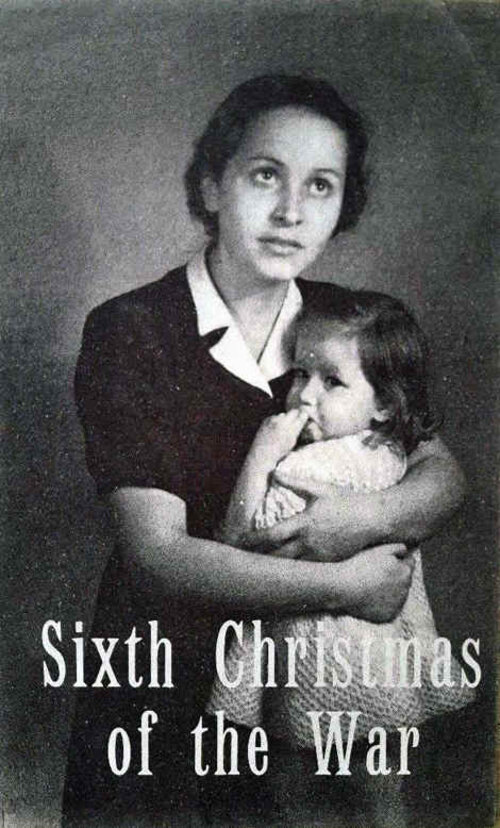
Sixth Christmas of the War
This American leaflet to German troops fighting in Italy is coded T-49. The front depicts a German wife at home with her daughter. Her face shows that she is deep in worry. The text under the photograph is:
Sixth Christmas of the War
The leaflet has a long propaganda text on the back. The text is:
German Soldier on the Italian Front!
What kind of Christmas Eve are your Dear Ones going to have? Do they still have a home in which to celebrate the birth of Christ? Will there be a good Christmas meal?
Or will the good cheer be disturbed by an air raid? Will your father have to do service with the Volkssturm in the Christmas night? Will your young brother and your little son be kept from the family circle by military duty? Is your wife all alone? Has your mother no one with which to sing the old Christmas carols? Is there no Christmas music in German except for the detonation of bombs and the shrill voice of radio propaganda…?
What will your dear ones be thinking that night, which should be a calm and holy night?
They will think of you, German soldier! They will think of the countless and senseless sacrifices which the continuation of the lost war imposes on you and on them and on everybody.
In their hearts there is only one great, anxious, urgent, desperate question:
HOW MUCH LONGER?
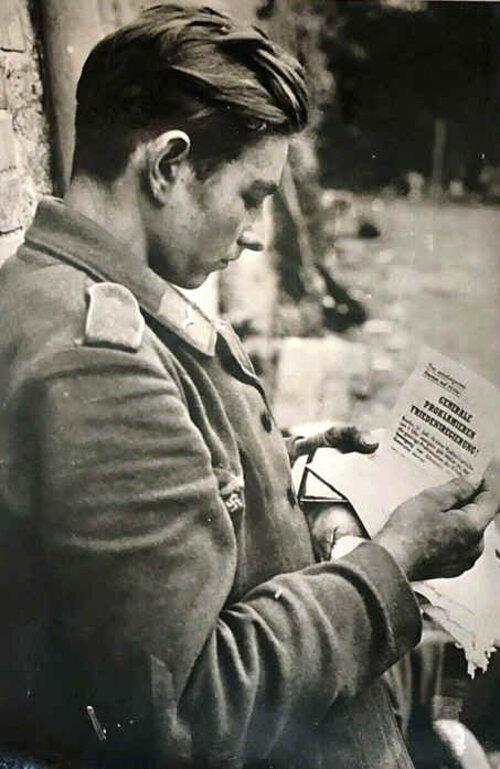
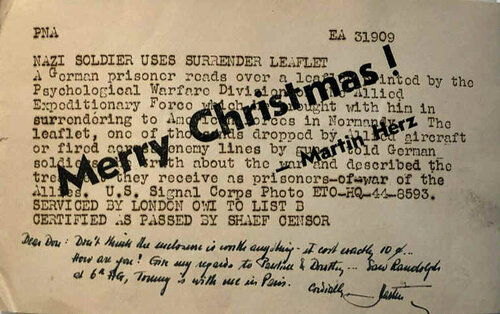
A Martin Herz Christmas Card
Martin Herz, was a Supreme Headquarters Allied Expeditionary Force (SHAEF) writer during WWII. After the war, he became an authority on psychological warfare and wrote numerous articles on the subject. He was credited with the production of this photograph depicting a German soldier reading an Allied propaganda leaflet. Herz apparently used this photo as a Christmas card, printing on the back “MERRY CHRISTMAS - Martin Herz.” The caption for the photo is:
NAZI SOLDIER USES SURRENDER LEAFLET
A German prisoner reads a leaflet printed by the Psychological Warfare Division of the Allied Expeditionary Force which he brought with him in surrendering to American forces in Normandy. The leaflet, one of thousands dropped by Allied aircraft or fired across enemy lines by guns told the German soldiers the truth about the war and described the treatment they receive as prisoners-of-war of the Allies.
U.S. Signal Corps Photo – London OWI – Certified as passed by SHAEF Censor.
The United Kingdom
On April 9th 1940, without a declaration of war, German forces occupied Denmark. The Danes offered no resistance. Germany exploited the country by having Denmark's National Bank pay for the costs of the occupation. Denmark's king and government remained in the country throughout the occupation so there was never a Danish government-in-exile. There was an active resistance movement. Starting about 28 September 1943, Danish underground anti-Nazi activists begin systematic smuggling of Jews to Sweden. Thanks to Danish underground operations, only 415 Jews are captured by the Germans. 7,000 were evacuated to Sweden. Other underground groups such as Holger Danske targeted individual collaborators. Denmark remained occupied until the end of the war.
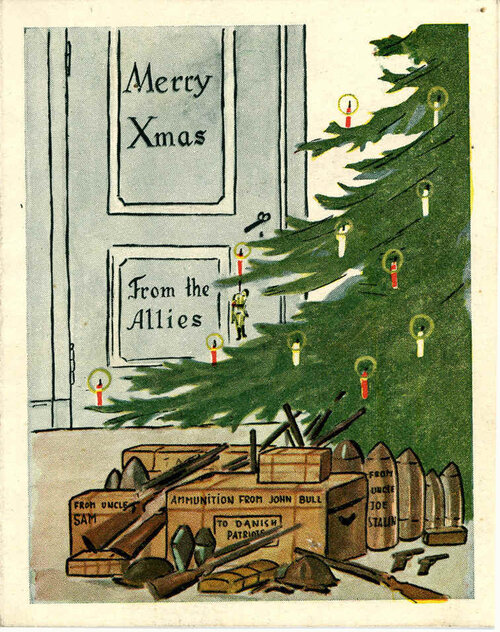
Britain for Denmark
The British produced a very imaginative Christmas card for the Danish people under German occupation during WWII. The front of the card is in full color. English-language writing on the panel of a door at the left is "Merry Xmas from the Allies." A decorated Christmas tree is at the right, and one of the decorations is a little Adolf Hitler hanging by his neck. The other decorations are all candles. The presents are depicted under the tree. There are crates labeled "Ammunition from John Bull to Danish patriots" and "From Uncle Sam." Scattered around the crates are rifles, artillery shells labeled "From Uncle Joe Stalin," pistols, mortar shells and helmets.
When opened, the text is "Julen 1944 - Glaedelig Jul og Godt Nytarr - Nheder fra Storbritanien." ("Christmas 1944 - Merry Christmas and a Happy New Year - from the people of Great Britain."). The rest of the card is blank, and it is uncoded.
My card has a penciled “763” on the front. The meaning is unknown, but it could be the British code for that particular production. It may be that all those explosives and ammo around the tree had a purpose. This greetings card was sent by Special Operations Executive inside container drops of weapons. So, it was more packaged than air-dropped in the traditional sense, and those weapons and ammunition would have been in the crate with the card.
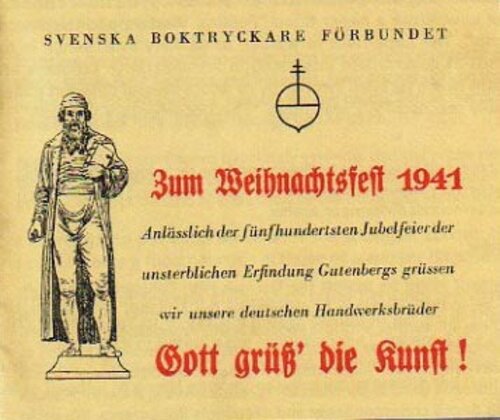
Britain for Germany
Researcher Lee Richards mentions several other British black Christmas cards in his book The Black Art. Two versions of such a card were created to be sent to German printing firms. One was allegedly from the Swedish Master Printer’s Association. The second was from the Association of Swiss Printers. The cards were virtually identical and both pictured Johannes Gutenberg, inventor of the printing press on the front. We depict the Swedish version of the card. The text is:
At Christmas 1941
On the occasion of the 500th anniversary of the immortal invention of Gutenberg, we greet our German brothers in the trade.
May God Bless our Art!
When opened, the card offers a verse from Deuteronomy at the left and a message at the right. The text is:
Cursed be he that encroaches his neighbor’s border. And all the people shall say Amen. Deuteronomy 27:17.
From books anyone can gain knowledge, in quiet and solitude, and this cannot be easily stopped; all that is needed is a single free piece of ground, where a printing press can spew forth its sheets! How could – with the enormous number of many kinds of books and so many copies of the same book, with new publications that rapidly multiply – how could anyone hope to firmly close all the doors through which the truth seeks entry?
400 copies of the Swedish version and 200 copies of the Swiss version were printed and sent into Germany through Stockholm and Berne. The German government complained and the Swedes allegedly offered a reward for the originators of the cards.
Germany
The Germans made great use of the Christmas motif in their propaganda, but few were actually in the form of a Christmas card. All we know about one card is the text. On the front it says "Hello there!" Text on the inside says, "We thought you would be home for Christmas. Well boys – take it easy – you've been promised so many things. It's not your first and certainly not your last disappointment. Cheer up – console yourself with Jerry. He wishes you a very merry Christmas and the best of luck in the new year."
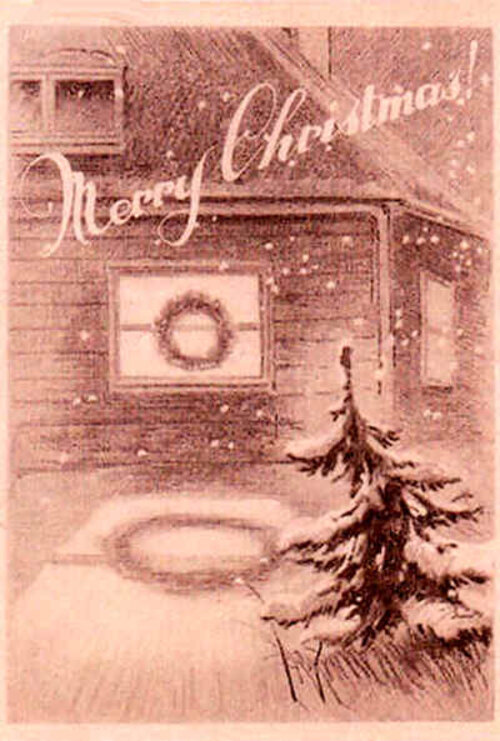
AI-174-12-44
The Germans prepared another leaflet in December 1944 for use against Allied troops in Italy that is not exactly a Christmas Card, but looks enough like one that it should probably be added to this story. The code “AI” is one of the six that the Südstern (Southern Star) Section of the SS-Standarte Kurt Eggers propaganda organization used against Allied soldiers fighting in Italy. After the attempt on his life, Adolf Hitler took the propaganda responsibility away from his military and gave it to his more loyal SS.
The front of the leaflet is a perfect imitation of a Christmas card. It depicts a small fir tree in the snow in front of a house with a Christmas wreath in the window and the words "Merry Christmas!" The back is all text:
"Let me live in a house by the side of the road and be a friend of man!"
Yes, that's it - and to be far away from war and senseless destruction from bloodshed and horror. It's the same with everybody. Bill, Sam and Joe say it's that way with them too.
Sure, you dream of that little place called your home. Didn't you say, "Me and Jeanne built that little home - that's our home."
Or perhaps she said, "Some day we are going to get enough saved up so we can buy that little plot out in the suburb, have a couple of apple trees, peaches or perhaps some strawberries."
What a word that is. "Mine, mine, mine." It makes your head stand up high and your chest stick out to say, "This is my house, my garden, how do you like them?" You liked to feel a bit independent when you said that.
AND NOW WHAT HAS BECOME OF YOU?
A soldier in the mud
Defending what?
Fighting for what?
And at home there's CHRISTMAS!
Well, make the best of it. Things will change for better or worse.
Meantime, that much abused National Socialist opposite is wishing you
A MERRY CHRISTMAS!

AI-175-12-44
A second Christmas leaflet from the same propaganda organization depicts a lonely mother with her children in front of a Christmas tree. One child asks:
Mom, why isn’t Daddy with us?
The back is all text and explains in depth that dad is too busy fighting the endless war in Europe to come home. Some of the message is:
Here we are again!
Another War Christmas!
Last summer you all expected the war would be over by October. October came and the war was still in full swing. Then you were sure it would be over by Christmas. Christmas is here now and the end of the war is not in sight…

Leaflet *350-11-44
Another German leaflet to Italy is coded *350-11-44 and also produced by the organization Südstern. The leaflet depicts a lonely British soldier standing in a snowstorm while owls watch him from a nearby barren tree. This leaflet was disseminated in November 1944. The text on the front is:
Merry Christmas
The back is a long text message which says in part:
Should auld Acquaintance be forgot…
Remember the Christmas we once knew?
The holly and the mistletoe, the rooms festooned with gaily colored steamers and decorations, the variety of good things to eat, the laughter and merry-making in an atmosphere of carefree friendship?
Remember how she happened to stand smack-bang under that piece of mistletoe, thus giving you a chance that you had been looking for?
And now – here you are standing in a muddy trench, and not even sure whether the parcel of cigarettes sent by loving relatives will escape the attention of those who handle them before you…
In this strain then, may “Jerry” wish you – the British soldier – a Merry Christmas!
The same vignette was used on a second Südstern leaflet coded *174-/12 44 disseminated in December 1944. This surrender leaflet was also for British troops fighting in Italy, but the message on the back was different and said in part:
HARK - THE HERALD ANGELS SING!
Pass the turkey Alf!
(It’s really “bully,” but a guy can pretend can’t he?)
Fill my glass up again with that excellent sherry.
(This bloody char gets worse!)
If I go on eating at this rate I simply won’t be able to eat any Christmas pudding.
(Boiled duff six days running – who called the cook…)
The Germans are trying to amuse the British with a friendly comical slang message. For instance, “Duff” is useless, junk or trash. The leaflet ends with a surrender message and
A very Merry Christmas! – Think it over!
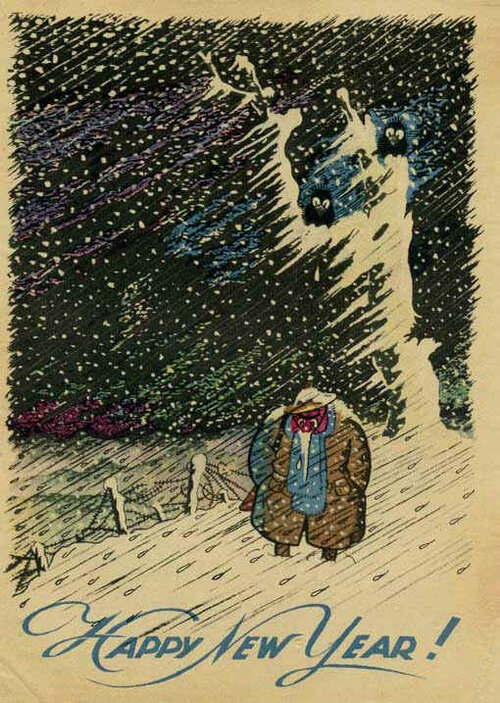
Leaflet *380-12-44
The Germans used the same vignette a third time on leaflet *380-12-44 in December 1944 but with the title:
Happy New Year!
The long message on the back reminisces about the old days of Happy New Years, and then talks of the present and homesickness, danger and death. The message ends with an anti-Semitic comment:
All you can do now is hope that it won’t be long before the Jews and moneygrabbers have filled their pockets sufficiently to call an end to wholesale slaughter and allow you to get back to a normal life?
A Merry Christmas!
This German leaflet depicts a wife and children at Christmas with the grandparents at their right. The text is written in a homey southern style and reminds of us old-fashioned country folk. The back has a rather long message talking about Christmas in the old days and then goes on to recommend that the soldier be injured and states that he can be home by Christmas with any luck. It tells the soldier that he won’t be kept in France because of the need for beds due to massive Allied casualties. He will be sent home. The code of this leaflet is “A.” We don’t know much about the unit that produced these leaflets except that it was German and produced a number of such leaflets for Allied troops in Western Europe in January of 1945. For instance, another leaflet with the “A.” code was entitled “To the Men of the British 2nd Army.”
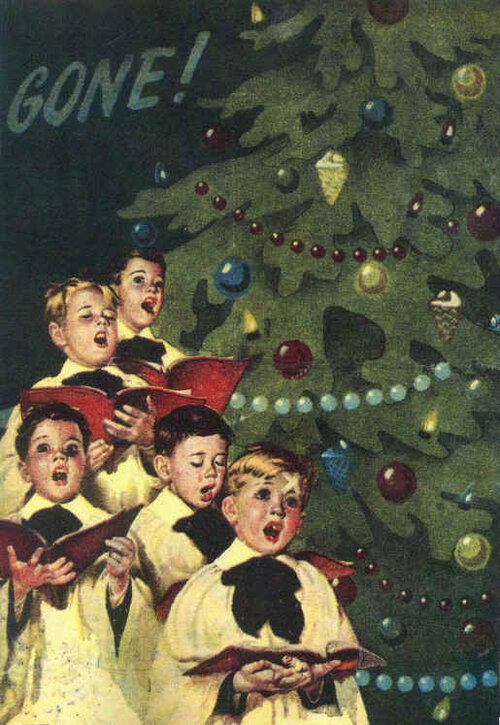
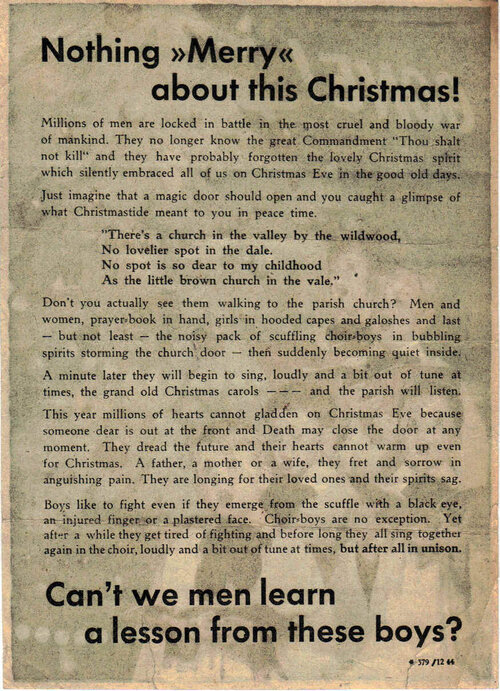
Leaflet *379-12 44
This Südstern leaflet depicts a group of children singing carols by a Christmas tree. The text on the front is:
GONE!
The back is a long all-text message that says in part:
Nothing “Merry” about this Christmas!
Millions of men are locked in battle in the most cruel and bloody war of mankind. They no longer know the great Commandment “Thou shall not kill” and they have probably forgotten the lovely Christmas spirit which silently embraced all of us on Christmas Eve in the good old days…
How strange to find the Germans who started the war when they attacked Poland without warning, and put Christian leaders who did not follow the Nazi line in concentration camps, suddenly reminiscing about the good old days and why nations should not fight.
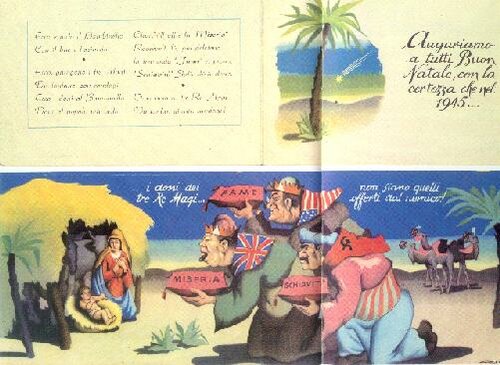
They also produced a colorful Christmas card for the Italians who they hoped to motivate and keep as allies. The front of the card show a palm tree and a falling star. The title of the card is “Merry Christmas to everybody, surely knowing that in 1945…” On the back of the card there is a longer message in the form of a poem, “There, the little Child was born with the ox and the ass. There, the three Magi arrive from far away. They are wandering. There, the gifts to the little child. Gifts to the nicest people. Churchill offers destitution. Roosevelt gives the most terrible famine and, a prone Stalin gives slavery. Long live, long live the three Magi Kings who came from far away, wandering!
When opened the card shows a scene of the three caricatured Allied leaders offering gifts to Mary and the baby Jesus. The text on the inside of the card is “…the gift of the three Magi are not the gift of the enemy...we don’t make the same offer to our enemy.”
The literal interpretation of the card makes no sense so I asked an Italian specialist to explain what he thought the Germans were trying to say. He came up with “"This year (1944) the enemies gave you misery and famine as a Christmas gift; but we hope that next year (1945) German troops will give you a rich and healthy Christmas.” I am not sure how he got from the text to his translation, but the way he interprets the meaning of the propaganda message makes sense.
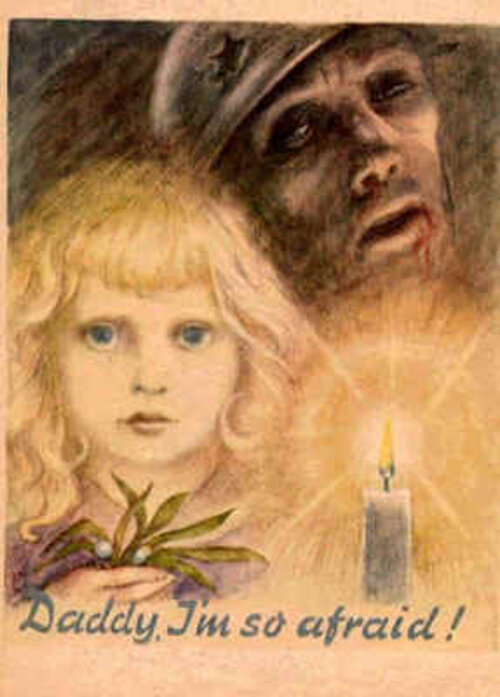
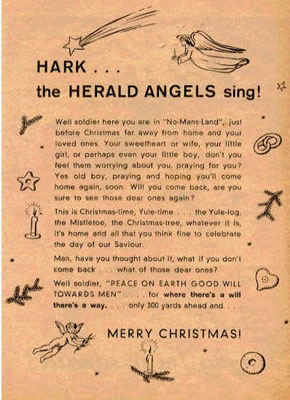
German Christmas Leaflet
The German leaflet depicted above is not in the form of a Christmas card, but it makes use of so many Christmas symbols that I have decided to add it to this article. The uncoded leaflet was printed in full color and dropped on members of the American 101st Airborne Division surrounded in Bastogne during the "Battle of the Bulge."
The front of the leaflet depicts a small blond-haired girl holding a sprig of mistletoe with a candle to her right. Behind her is the visage of her father, apparently killed in action with a bullet hole in his helmet, although his eyes are partially open. The text is “Daddy, I’m so afraid!”
On the back of the leaflet there are a barrage of Christmas symbols surrounding the text. Among them are angels, the Star of Bethlehem, Christmas candles and pine sprigs, etc. The text is terribly written and full of grammatical errors. It is:
HARK…the HERALD ANGELS sing!
Well soldier, here you are in “no-Mans land,” just before Christmas far away from home and your loved ones. Your sweetheart or wife, your little girl, or perhaps even your little boy, don’t you feel them worrying about you, praying for you? Yes old boy, praying and hoping you’ll come home again, soon. Will you come back, are you sure to see those loved ones again?
This is Christmas time, Yule-time . . . The Yule-log, the Mistletoe, the Christmas tree, whatever it is, it’s home and all that you think fine to celebrate the day of our Savior.
Man, have you thought about it. What if you don’t come back . . . what of those dear ones?
Well soldier, “PEACE ON EARTH GOOD WILL TOWARDS MEN” . . . for where there’s a will there’s a way . . . only 300 yards ahead and
MERRY CHRISTMAS!


Leaflet * 377-12-44
Although not a Christmas card, German leaflet * 377-12-44 depicts a Yule scene with a young child reaching into a Christmas sock with toys on the floor and a Christmas tree to the left. Over this happy scene the Germans have placed the symbol of Death strangling a soldier and the text:
Where might daddy be on this holy night?
The back has a long propaganda text including some of the following:
Somewhere a child is weeping on this holiday night.
Tired of the glare of the lights and from playing with all his new things the little boy has been brought to bed by his mother. The wooden soldiers, the grim-looking nut-crackers, the pipe and drums lie scattered under the Christmas tree with its dying candles.
“Good night my darling, sleep well.”
Good night mother. Good night wooden soldier. Good night brown teddy bear.”
The vaulted roof of the star-lit sky stretches over the little house somewhere in far off America.
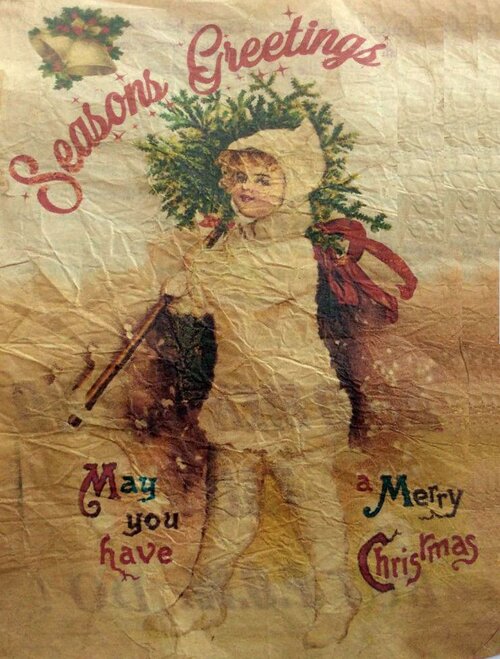
Leaflet *378-12-44/12
This German Christmas Sudstern (Southern Cross) leaflet is coded *378-12-44/12, which indicates it was disseminated in December of 1944. The front depicts a young child carrying a Christmas tree and the text:
Seasons Greetings
May you have a Merry Christmas
The text on the back says:
Christmas is not a time nor a season, but a state of mind. To cherish peace and goodwill, to be plenteous in mercy, is to have the real spirit of Christmas
John Calvin Coolidge Jr.
Soldiers of the 9th and 10th Tank, 101st Parachute and 28th Infantry Divisions, did your officers tell you that you are surrounded and outnumbered here? Well, here you are just before Christmas far away from home and stuck in the worst imaginable military situation. Will you come back, are you sure to see your loved ones again? Put a stop to it now...one way or another.
DEAD MEN TELL NO TALES, BUT POWs DO!
Note: because of the mention of the 9th and 10th Armored Divisions, and the 101st Airborne and 28th Infantry Divisions we can say that this leaflet was probably dropped on Bastogne. The time is right and all the mentioned units were there. There is one problem with this leaflet. The Southern Star leaflets were dropped in Italy. In fact, the two leaflets on either side of this one, *377-12-44 and *379-12-44 were both dropped on Italy. BUT, notice that this leaflet *378-12-44/12 has an added 12 at the back. I can only assume that it was considered such a powerful leaflet that it was taken from Italy with a slight change in code number and dropped on Western Europe.
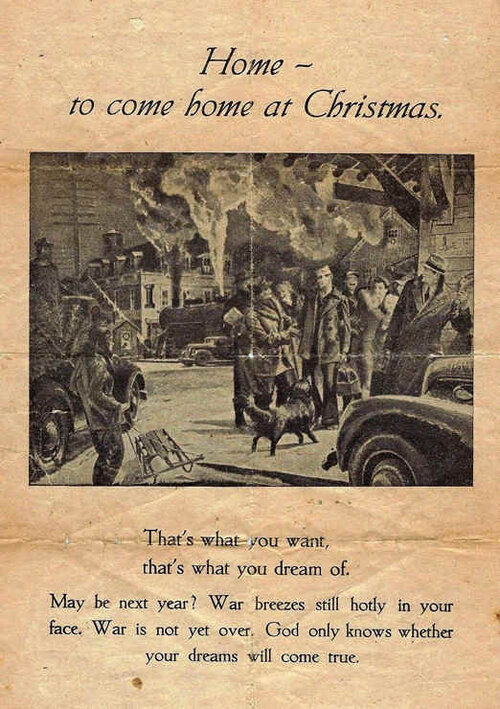
Leaflet 981144/2
The 981144 series consists of at least 22 leaflets. A second series was coded 981244, and I know of at least 48 leaflets from that series. Leaflet 981144/2 depicts a happy crowd around a returning American serviceman at Christmas. This leaflet was first dropped in November 1944. The title is:
Home - to come home at Christmas
Four paragraphs on the back tell the American soldier that the war is not over yet, and he could come home crippled or maimed for life. It tells the soldier that he is fighting for nothing, to free the Poles from the Germans just to see them occupied by the Russians, or to see the Communist Tito raise the Red Flag over the Balkans.
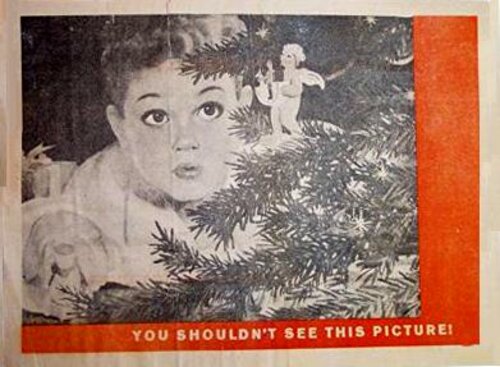
Leaflet 981144/11
Another German propaganda leaflet that uses Christmas as a theme is coded 981144/11. The code indicates that the leaflet was disseminated over the Allies in Western Europe in November 1944 . The front of the leaflet depicts a child looking at an angel on a Christmas tree with the text:
YOU SHOULDN’T SEE THIS PICTURE!
The back is all Text:
ONWARD CHRISTIAN SOLDIERS!
Forget those millions of little kids who will have no Christmas.
Forget those children who are waiting in vain for their fathers to come home, those innocents who will never look into their father’s face.
Those poor ones who even at Christmas, living in ruins, will hear the crash of bombs.
Forget them! Don’t think of them, it breaks the morale of the soldier.
War goes on. Murder is still legalized and there is no end in sight.
ONWARD CHRISTIAN SOLDIERS!
Note that the Germans often produced leaflets with the text “Waiting in Vain.” This leaflet falls into that category. It is also interesting that after starting World War Two by attacking and bombing Poland, and later all of Europe and the Soviet Union, the Germans are suddenly worried about the fate of little children.
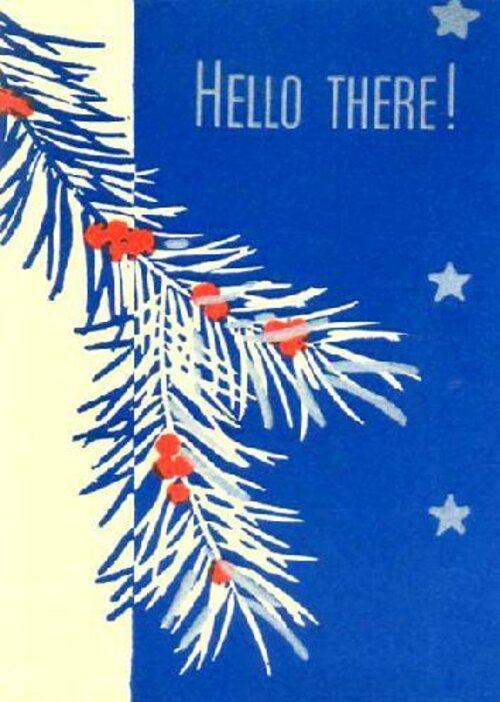
German Christmas booklet
This uncoded full-color German booklet was disseminated over American troops about December 1944. It clearly attempts to look like a Christmas card. The front shows a decorated branch and the text:
HELLO THERE!
Text on the back under another decorated branch is:
We thought you would be home for Christmas
Well boys – take it easy – you’ve been promised so many things.
It’s not your first and certainly not your last disappointment.
Cheer up – console yourself with Jerry
He wishes you a very MERRY CHRISTMAS and the best of luck in the NEW YEAR
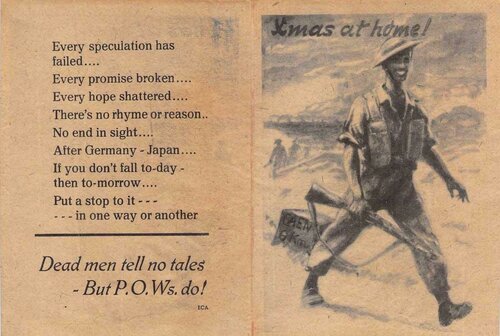
The German leaflet above coded “ECA” approximates a Christmas card in that it is folded with a front and a back and two inside pages.
The Front of the “card” depicts a smiling British soldier six kilometers from Caen, France and the text:
Xmas at home!
The back is all text:
Every speculation has failed….
Every promise broken….
Every hope shattered….
There’s no rhythm or season.
No end in sight….
After Germany - Japan….
If you don’t fall today – then tomorrow….
Put a stop to it - in one way or another
Dead men tell no tales – but P.O.W.s do!

When opened, the left page depicts a soldier under artillery fire and the text:
Xmas at home?
The right page shows the soldier dead while a crow studies him from the stock of his rifle and the text:
Xmas….
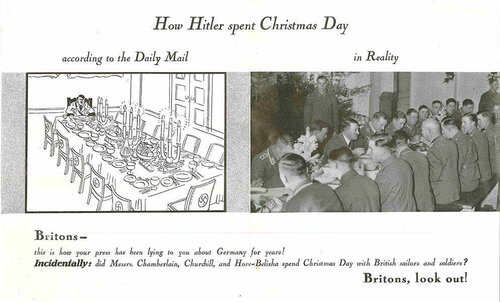
How Hitler spent Christmas Day
This Christmas leaflet was actually a pre-war product sent from Germany to the United States in March 1940 in an attempt to make the Americans side with the Germans or at least remain neutral. The Germans were fighting England and France; Roosevelt was dying to take the side of England and the Germans were trying to build public pressure for the U.S. to stay neutral. The front of the leaflet is a plain white folded square with no images and just the text:
Hitler and his friends
When unfolded, the other side is entitled: “How Hitler spent Christmas Day” with the statement “According to the Daily Mail” and a caricature drawing showing Hitler dining alone like an Emperor. To the right is photograph labeled “in Reality” showing Hitler dining happily with his soldiers in the field and text beneath both images:
Britons –
This is how your press has been lying to you about Germany for years!
Incidentally: did Messrs. Chamberlain, Churchill, and Hore-Belisha spend Christmas Day with British sailors and soldiers?
Britons, look out!
In the envelope with the leaflet were three anti-British propaganda postcards. The cards are printed black on white stock; they show no legends or codes identifying the preparers so they are considered to be "black" propaganda.
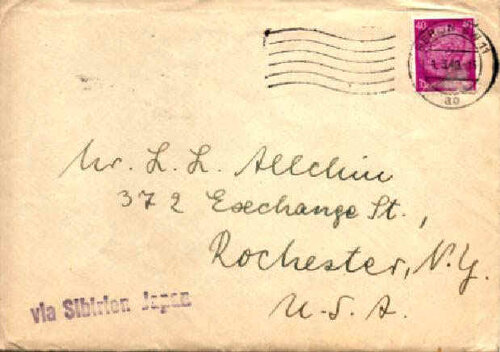
An actual mailing envelope
In 2017, Jim Allchin wrote to say:
I actually have one of those Christmas cards: “How Hitler Spent Christmas Day” that was sent to my grandfather with the envelope from Germany and the additional three anti-British propaganda postcards.
Typical envelopes bear a 40-pfennig Hindenburg stamp, which was the correct postage for foreign mail up to 40 grams. The envelopes were shipped by way of the Siberia-Japan mail route to avoid British censorship.

The Chancellery in Berlin in 1937
As long as we are showing some German propaganda picturing a happy Hitler celebrating Christmas I thought it would be nice to add this one, the Fuhrer receiving gifts at a 1937 Christmas Party. I am assuming he was a good boy and not naughty. Santa Claus obviously knows what is good for him.
The Soviet Union
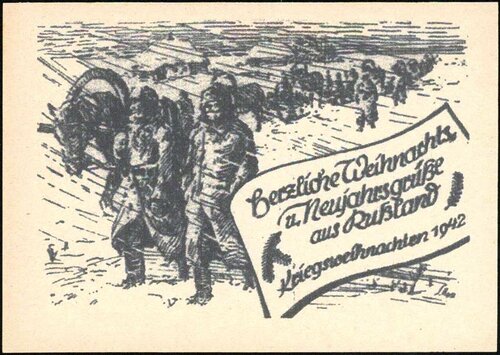
Christmas War
The USSR prepared many leaflets and cards that used Christmas as propaganda, knowing that it was an important holiday for the Christian Germans. I could depict dozens here, including propaganda newspapers, but they are all very similar and the message is repetitious, so I will just show five “Christmas cards” in this section. The above 1942 Soviet propaganda card depicts German soldiers and their beasts of burden walking through a freezing snowstorm somewhere on the Eastern front. Curiously, a similar card exists that shows a snowy mountain in the form of a Christmas tree in the background and shows the same line of people very small and far away. The text is:
Warm Christmas and New Years greetings from Russia.
Christmas in war 1942
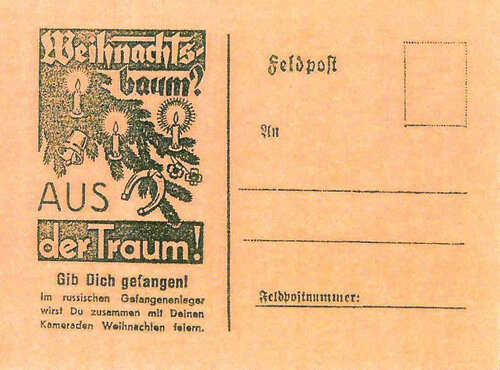
It’s all Over!
This propaganda postcard-leaflet depicts candles on a Christmas tree on a bright orange cardboard. 5,000 copies of the card were printed on 9 December 1942. The text is:
Christmas tree?
It’s all Over!
Surrender! In the Russian POW camp you will celebrate Christmas together with your comrades!
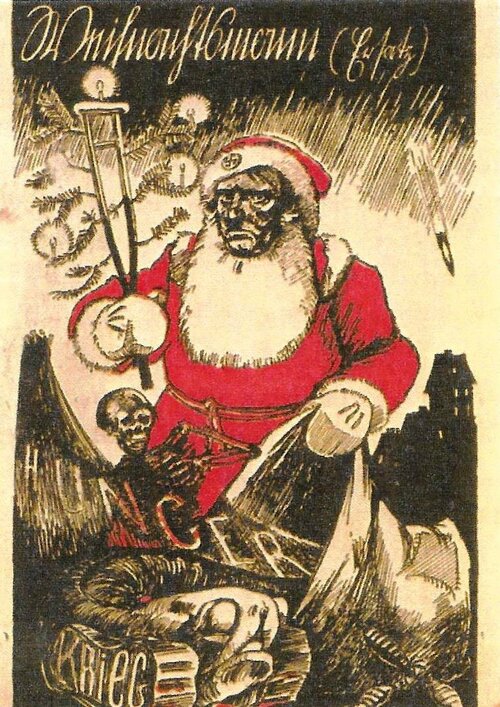
Fake Santa Claus
The Christmas card above depicts Hitler as Santa Claus with a white beard holding a crutch as a Christmas tree and a bag of gifts with the words “Hunger” and “War.” Some of the text on the front and back of the card is:
Substitute Santa Claus
Look at this Santa Claus. It is not the usual kind of Santa Claus, the good-natured grandfather who once brought you a number of kind presents. This Santa Claus with the gangster face brings you gory presents for 1942. He brings want and misery which will be even more dreadful than in the past year. He brings battles even bloodier than past ones and unspeakable pain and suffering. In the end, the final catastrophe of Germany. Will you accept these presents?
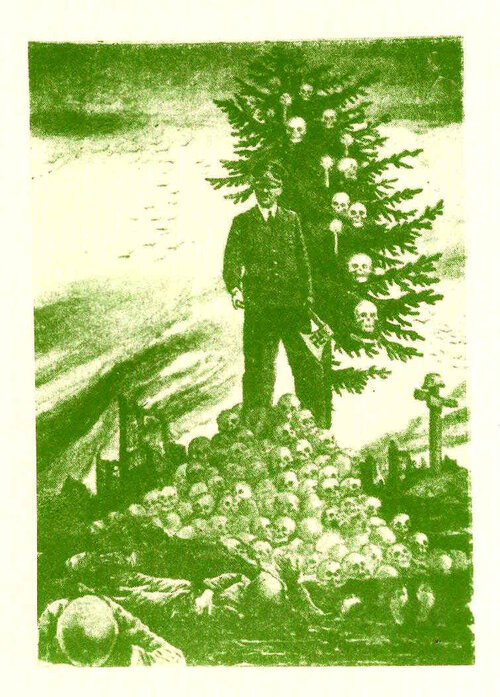
German Soldiers!
The image of Hitler standing on a pile of skulls was used in several Soviet leaflets. In this December 1941 Christmas card, the fir tree behind Hitler is decorated with skulls and is meant to represent a Christmas tree. There is no text on the front. The propaganda text on the back is:
German soldiers! Hitler is the guilty one in the death of millions of German soldiers. He has driven you into the endless Russian plains. He caused you to suffer and to die for a worthless cause. Overthrow Hitler and stop this war of pillage.

The Fuehrer’s Present for the German People
This is another very interesting Russian image using the theme of Christmas. This leaflet depicts Hitler as Santa Claus carrying bags of gifts for the German people. Among the gifts are skulls, coffins and scaffolds. The Russians were masters of these satiric images. The card is coded 578. As expected the back as a long propaganda text that starts and ends with:
Come all ye Children.
Put an end to Hitler and the brown plague! Put an end to the war!
Korean War

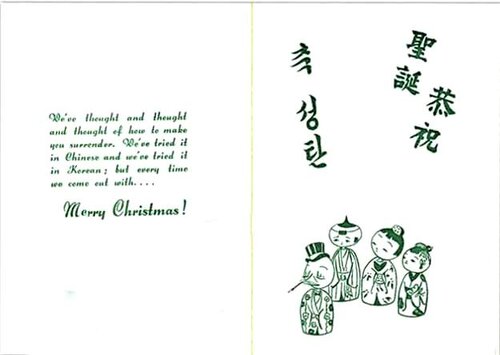
1st Radio Broadcast and Leaflet Group Korean War Christmas card
1st loudspeaker and Leaflet Company Korean War 1952 Christmas card
Every PSYOP unit has a printing section they can print such items as calendars, stationery pads, menus and of course, Christmas cards. This Christmas card from the main American PSYOP unit in Korea features their mascot “the Proper Gander” on the front. The gander is in front of a microphone, representing the “Radio Broadcasting” section and surrounded by falling paper representing the leaflet section. Inside the card here were four little Korean dolls, three women and one a goose in Korean garb. The text on the inside was:
We’ve thought and thought and thought of how to make you surrender. We’ve tried it in Chinese and we’ve tried it in Korean; but every time we come out with…MERRY CHRISTMAS!
Veritas adds:
"Proper Gander" was featured on 1st RB&L Christmas cards designed by the Graphics Section. They sold for a piddling 3.5 cents when beer cost a nickel and a high ball sold for a quarter in Japan. A Christmas card was an easy way to claim credit for writing home.
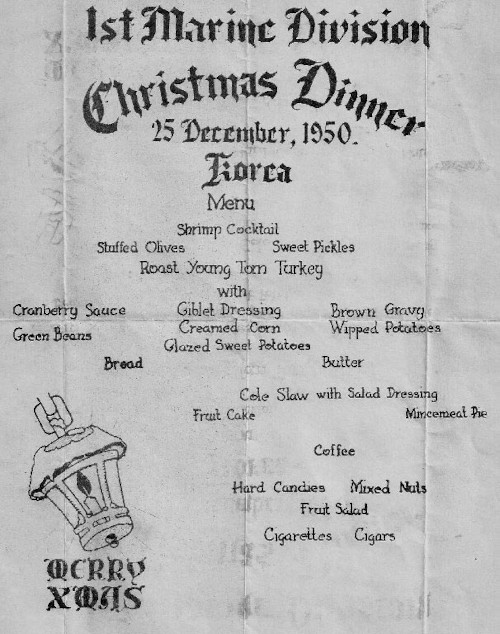
1950 Marine Christmas menu – Chosin Reservoir
In late 1950, eight thousand men, most of them United States Marines, surrounded by 120,000 Chinese soldiers, struggled to survive the coldest winter in 100 years in North Korea. They became known as “The Frozen Chosin.” They had been told that by pushing the North Korean Army all the way up to the Chinese border that first year they would be home for Christmas. That was not to be. Chinese “volunteers” entered the war, caught American Intelligence by surprise and nearly captured the entire 8,000 men. Instead, the Marines fought their way back to Allied lines. Christmas dinner that year was special. One joker said that it was so cold the hot turkey drumsticks turned into Popsicles before they could be eaten.
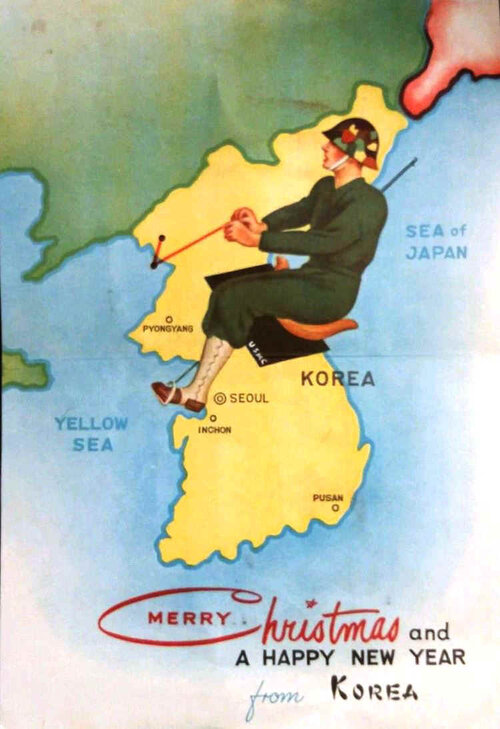
Marine riding a Bucking Bronco Korea
This North Korean propaganda Christmas card was prepared for United States Marine troops during the winter of 1950. From 27 November to 13 December 1950, 30,000 United Nations troops were encircled and attacked by approximately 120,000 Chinese troops near the Chosin Reservoir. The UN forces fought their way through the Chinese forces but along with U.S. Army forces were forced to withdraw from North Korea. By 10 December the troops had begun to enter the port of Hungnam where 200 ships rescued about 105,000 UN troops.
The card looks to be an American product at first, but the “rainbow” helmet makes no sense, and the Marine is riding Korea like a horse with the reins part of North Korea that he had been driven from. This card was sent home to the United States as a North Korean souvenir in February of 1951 by a Marine.
During the Korean War our enemies prepared a great amount of propaganda in the form of Christmas cards. ChristmasCard 120 below was prepared for the 1951 Christmas season. It was illustrated in Armed Forces Talk, No. 424, 24 October 1952.
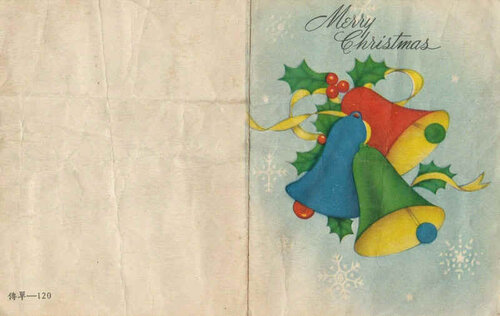
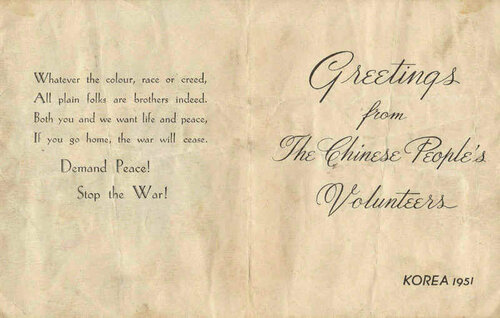
Chinese Propaganda Christmas card No.120
1. A multicolored card depicting ringing bells and holly with the English text "Merry Christmas" on front. The back of the card is blank except for the code number "120" preceded by two Chinese characters that read "propaganda sheet." The card opens to reveal text at the left:
Whatever the colour, race or creed, all plain folks are brothers indeed. Both you and we want life and peace, if you go home, the war will cease.
Demand Peace!
Stop the War!
The text at the right reads:
Greetings from the Chinese People's Volunteers
Korea 1951.
The folded card is 95 x 120 mm. This card is also known in a monotone (lilac) version. This may be a genuine Communist product or may be a later private reprint.
About the same time the Communists prepared a black and white leaflet coded 111 with a photo of U.N. soldiers on patrol in the bitter Korean winter. It was entitled:
Many Went Out, but Few Came Back
It is not in the form of a Christmas card, but did use Christmas as a theme. Some of the text on the back is:
Winter 1951
Last winter MacArthur said “Home by Xmas.” He’s back home but you’re still here. What will Ridgway cook up for Christmas this winter to keep you in line?
Use your head
Demand Peace! Stop the war!
The Communist Chinese struck again during the 1952 Christmas season. They crept near UN lines under cover of night and decorated the barbed wire with various presents such as candies, writing paper, Chinese stamps, and at least two Christmas cards in a professed gesture of peace and friendship.
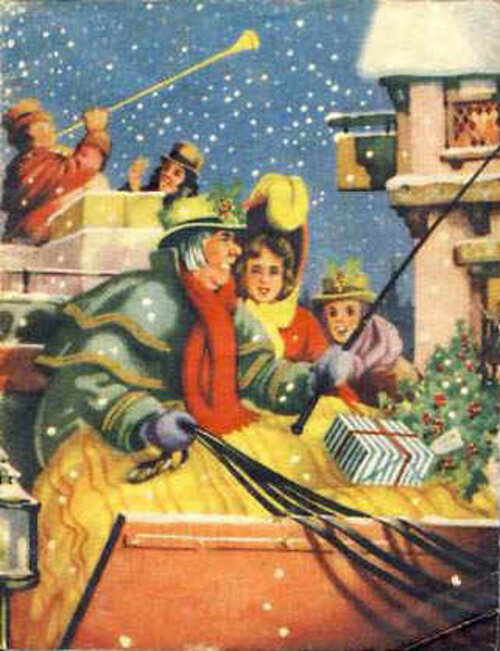
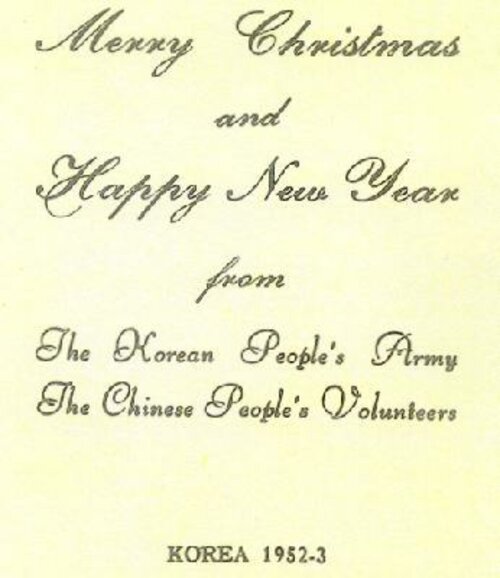
Front of Korean Christmas card #154A

Back of Korean Christmas card #154A
2. A double-folded multi-colored Christmas card for British troops. The outside front shows a traditional English coach scene outside a hostelry. The outside back is blank except for the code number 154A. When unfolded the left side of the card shows the text "Merry Christmas and Happy New Year from the Korean People's Army / the Chinese People's Volunteers – Korea 1952-3." The inside right shows the text "Where there is Peace there is blessing (see inside)." When unfolded a second time, the back of the leaflet has a long typewritten message aimed at British officers and troops. Some of that text says, "It is 28 months since the Yanks dragged Britain into this war. Nearly 10,000 British lads have been killed or wounded in this period (actual number of casualties to September 1952---9393). The Gloucester Regiment has suffered particularly heavy losses as a result of American selfishness. Now British soldiers have also been rushed to Koje Island where the Yanks have been committing the most terrible crimes against the prisoners of war…" When folded the card is 85 x 110 mm.

3. A triple-folded card for US troops. The outside front shows the word "Peace" in yellow with red trim, with a border of holly leaves in green and red. The outside back is blank except for the code number 155A. When unfolded the message at left and right is exactly the same as card 154A above. This card is opened to show an extensive typeset message for US troops, that is continued on two additional pages visible after a third unfolding. Some of the message says "American Soldier: We are wishing you a Merry Christmas and a Happy New Year. We also have something to talk to you about…You are far away from those you love, in Korea, a country you never heard of three years ago – hundreds of thousands of casualties ago…Why are Americans sent abroad to do this kind of dirty work, the exact opposite of every fine thing America ever stood for…Don't believe the Big Money boys and politicians at home…they are no different than Chiang Kai-shek whom we ran out of China. Don't do what they want. Do what the people want."

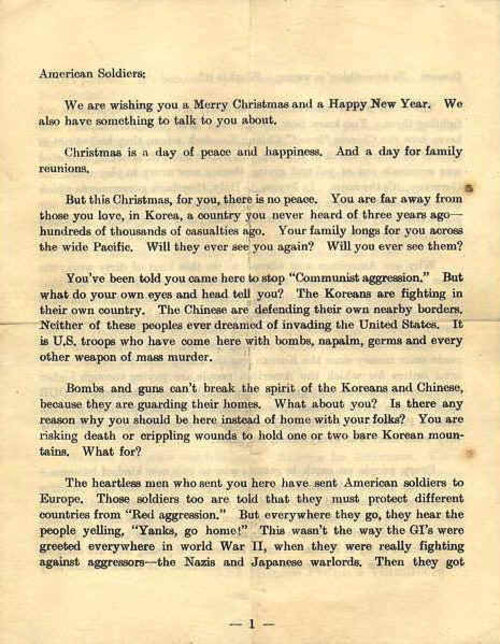

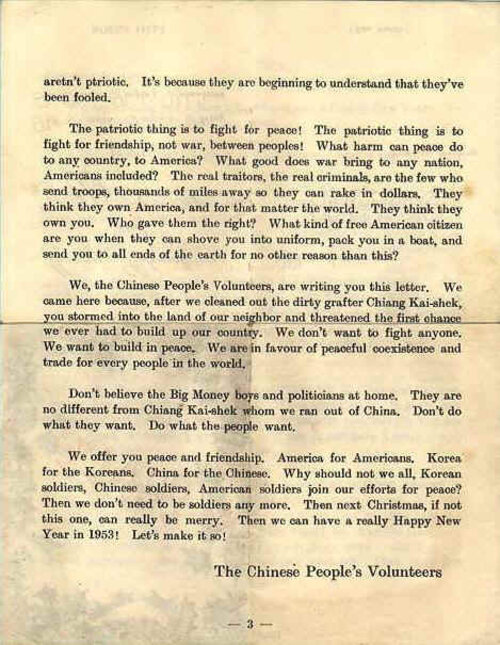
4. There is a second single-fold version of this full-color Christmas card. Once again the card has the word "Peace" bordered by green holly leaves and red berries on the front. When opened, the size of the card is 168 x 107 mm. Text on the left side of the card is "Merry Christmas and Happy New Year." Text on the right side is "Where there is Peace there is blessing." No political propaganda appears on this card. The code number at the lower right on the back of the propaganda piece is 155B.
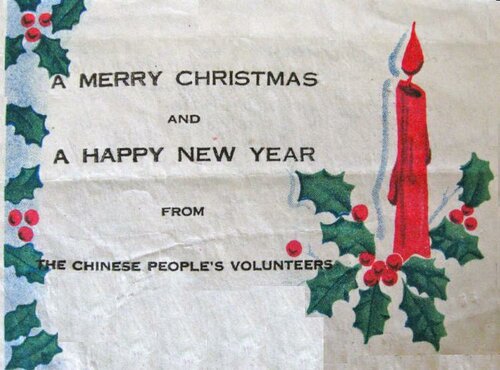
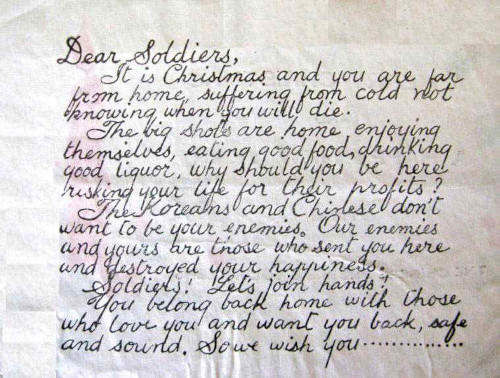
5. Another full-color Christmas card from the Communist Chinese shows a candle and holly leaves on the front and the text:
A Merry Christmas and Happy New Year from the Chinese People's Volunteers.
This card is undated so there is no way to tell when it was disseminated although it is assumed that the year was 1951. Text on the back is:
Dear Soldiers, It is Christmas and you are far from home, suffering from cold not knowing when you will die.
The big shots are home enjoying themselves, eating good food, and drinking good liquor.
Why should you be here risking your life for their profits?
The Koreans and Chinese don't want to be your enemies.
Our enemies and yours are those who sent you here and destroyed your happiness.
Soldiers! Let's join hands!
You belong back home with those who love you and want you back, safe and sound. So we wish you........
One veteran reported about finding this card during the winter of 1951-52:
The 40th Infantry Division relieved the 24th Division right after Christmas 1951. Shortly after we got to our position on the main line of resistance, I went out to the outpost line of resistance to see for myself what things looked like. One of the GIs manning the outpost showed me the Chinese Christmas card. He said they found dozens of them hanging on the barbed wire around their trenches on Christmas morning. (The hole at the top is from hanging it on the barbed wire.).
The scary thing is that the outpost was ringed with mines, barbed wire, booby traps, trip flares and assorted noise makers put there specifically to warn of an enemy approach at night. And yet the Chinese had succeeded in creeping through or around the mine field and barbed wire without alerting the outpost soldiers in order to hang their leaflets. The GIs realized the next morning that the Chinese could just as well have attacked them, but chose not to in order to deliver their propaganda message.
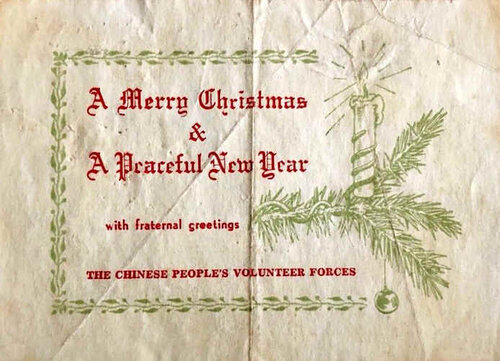
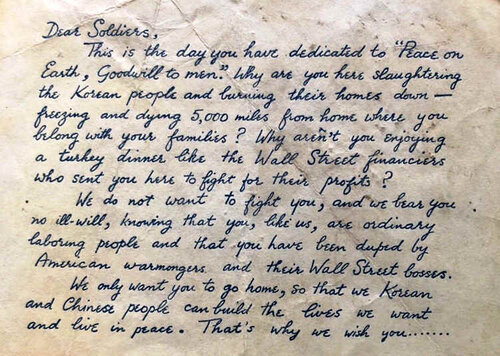
6. This card from the Chinese is very similar to the one above, but depicts a candle and pine bough. The text is:
A Merry Christmas and a Peaceful New Year with Fraternal Greetings
The back is all text and says in part:
THE CHINESE PEOPLE’S VOLUNTEER FORCES
This is the day you have dedicated to “Peace on Earth, Goodwill to men.” Why are you here slaughtering the Korean people and burning their homes down – freezing and dying 5,000 miles from home where you belong with your families? Why aren’t you enjoying a turkey dinner like the Wall Street Financiers who sent you to fight for their profits?
Dan King mentions the above leaflet in The Yalu River Boys, Pacific Press, North Charleston, NC, 2018, about his father who was a prisoner in North Korea after his B-29 was shot down. The story mentions The North Korean presenting these cards to the POWs in December 1951:
The Guards passed out leaflets that were adorned with an intricate drawing of a yuletide candle, a pine bough, a Christmas tree ornament and the words “Merry Christmas.” This Christmas greeting was in stark contrast to the corpses stacked in the outdoor morgue; men who were murdered by willful neglect.
Korean War Propaganda leaflets that use Christmas as a Theme
As you will see in the Vietnam section below, it was not only Christmas cards that were prepared for use against the enemy. Many times leaflets were prepared that used Christmas as their major theme in an attempt to demoralize Christian troops. I illustrate four interesting ones below. All were prepared by the Communist Chinese forces for use against Allied troops.

Mr. Moneybags
Leaflet # 117 shows two pictures on the front. The first photo is of two men and two women in swim suits sitting at a table with drinks by a pool in Florida. The text under the photo is:
Mr. Moneybags in Florida this Christmas.
The second photo is of GI's marching over the mountains through the snow. The text under the photo is:
Where are you? In Korea? You risk your life, Big Business rakes in the dough,
This leaflet was depicted in a U.S. Army Korean War film on psychological warfare. The narrator stated that this photograph was originally stolen from a magazine advertisement for cigars, (and note that one man is smoking a cigar) and goes on to say that the liquor glasses were later added by the North Korean Communists. If you look at the glass in the hand of the man at the right it does appear to be drawn.
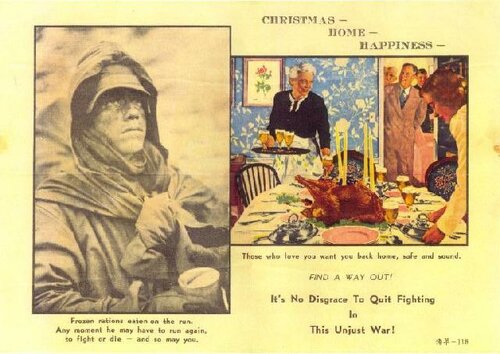
Christmas – Home – Happiness
This Christmas leaflet coded # 118 has two pictures on the front. The photo at left depicts a cold and unhappy soldier and the text:
Frozen rations eaten on the run, any moment he may have to run again to fight or die - and so may you.
The second picture shows a Christmas feast (the Chinese have added a turkey instead of a ham so it looks suspiciously more like a Thanksgiving dinner than a Christmas dinner). The family prepares to sit down for a happy holiday meal. The text accompanying this picture is:
CHRISTMAS - HOME - HAPPINESS
Those who love you want you back home, safe and sound.
FIND A WAY OUT!
It's No Disgrace to Quit Fighting in This Unjust War!
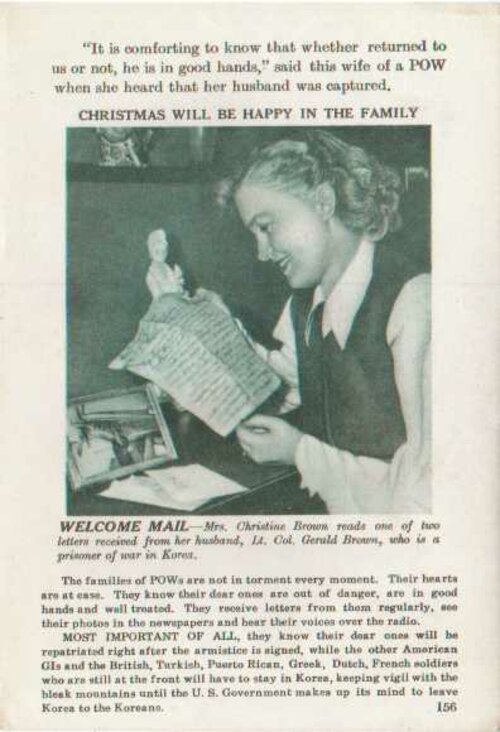
Christmas will be Happy in the Family
This Christmas Leaflet code # 156 depicts a Mrs. Christine Brown reading one of the two letters she received from her husband Lieutenant Colonel Gerald Brown, who is a prisoner of war in Korea. The back of this leaflet is blank.
The text is
“It is comforting to know that whether returned to us or not, he is in good hands," said the wife of a POW when she heard that her husband was captured.
CHRISTMAS WILL BE HAPPY IN THE FAMILY
The families of POWs are not in torment every moment. Their hearts are at ease. They know their dear ones are out of danger, are in good hands and well treated. They receive letters from them regularly, see their photos in newspapers and hear their voices over the radio.
MOST IMPORTANT OF ALL, they know their dear ones will be repatriated right after the armistice is signed, while other Americans GIs and British, Turkish, Puerto Rican, Greek, Dutch, French soldiers who are still in the front will have to stay in Korea, keeping vigil with the bleak mountains until the U.S. Government makes up its mind to leave Korea to the Koreans.

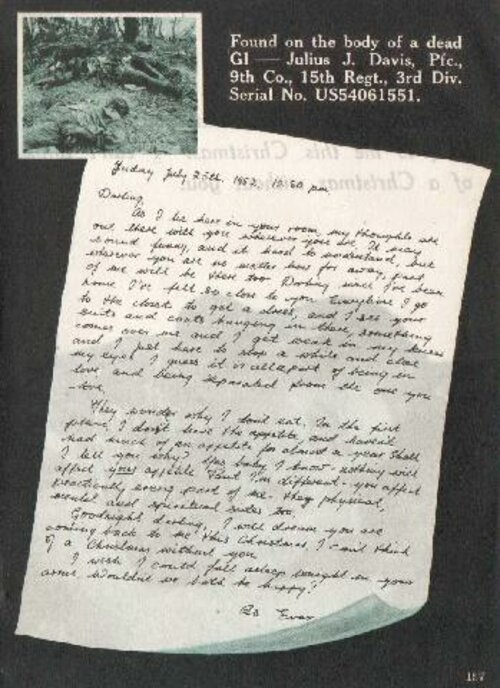
Darling, I will Dream…
This leaflet is coded 157 and surely was made by the same unit that made the previous one. The front of the leaflet depicts of a woman resting her head on her arms thinking about her husband or boyfriend. The text on the front is:
“Darling I will dream that you are coming back to me this Christmas. I can't think of a Christmas without you.”
The back of the leaflet has a photograph showing several dead UN soldiers on the ground and below it a hand-written letter. The text beside the photo is:
Found on the body of a dead GI -- Julius J. Davis, Pfc., 9th Co., 15th Regt., 3rd Div. Serial No. US544061551.
The inclusion of the name of the soldier, his serial number and unit, is meant to provide credibility to the letter below. The text of the handwritten letter on the reverse is:
Friday, July 25th 1952. 12:50 pm
Darling,
As I lie here in your room, my thoughts are out there with you wherever you are. It may sound funny, and it's hard to understand, but wherever you are no matter how far away, part of me will be there too. Darling since I've been home I’ve felt so close to you. Every time I go to the closet to get a dress, and I see your suits and coats hanging in there, something comes over me and I get weak in my knees and I just have to stop a while and close my eyes. I guess it is all a part of being in love and being separated from the one you love.
They wonder why I don't eat. In the first place I don't have the appetite and haven't had much of an appetite for almost a year. Shall I tell you why? Yes baby, I know nothing will affect your appetite. But I'm different you affect practically every part of me. The physical, mental and spiritual sides too.
Goodnight darling, I will dream you are coming back to me this Christmas. I can't think of a Christmas without you.
I wish I could fall asleep tonight in your arms. Wouldn't we both be happy?
As Ever,
The Cold War
During the 1950s when the West fought the East for the minds of the people in occupied Europe, Christmas cards were produced and disseminated several times by the American organizations Crusade for Freedom, Radio Free Europe Fund, Radio Free Europe, and Radio Liberty. Much of this material was discovered and published by my friend, researcher and author Richard Cummings.
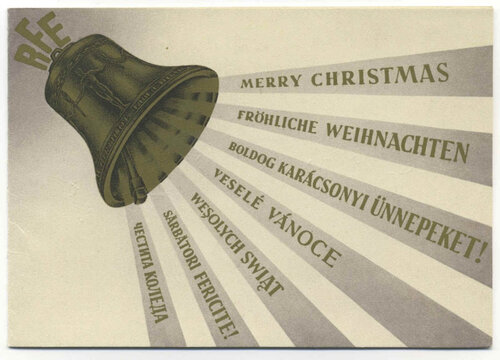
Radio Free Europe 1951 Christmas Card
Because Communism abhorred religion and banned it in many of the occupied nations, it was a perfect theme for propaganda by the West with the promise of freedom of religion and a return to the old days of Christian worship behind the Iron Curtain.
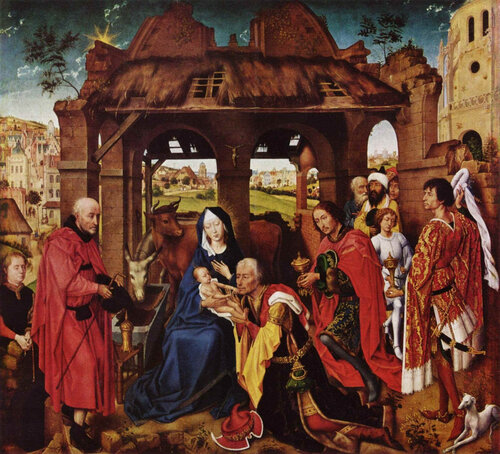
Free Europe Press 1955 Christmas Booklet to Czechoslovakia
During the Cold War, the Free Europe Press sent Christmas “cards” from Germany over the Iron Curtain via balloons: one to Czechoslovakia which was more in the form of a booklet and one to Hungary which was more like a leaflet. The card above, which was sent into Czechoslovakia was originally from a painting “The Adoration of the Magi” by Flemish artist Rogier van der Weyden. Some of the text in the booklet is:
Two thousand years ago, God sent his only begotten Son to redeem the world. Ever since, the world has been illuminated with the light from the manger in Bethlehem. Men bowed under sorrow and humiliation, men oppressed and persecuted draw from this light the patience and strength to await the day that will bring them peace, truth and freedom. On the threshold of the New Year, we bow before God and renew within ourselves love for our neighbor.

Free Europe Press 1954 Christmas Leaflet to Hungary
The leaflet to Hungary, disseminated during Christmas 1954, depicted a famous painting of Mary and Jesus by a fifteenth-century Hungarian Artist. The back contained a prayer and a message from Radio Free Europe. This leaflet angered a number of Hungarian government officials. These officials felt RFE was exploiting Hungarian culture for their own ends.
It is possible that a Christmas leaflet was also sent to Poland, but if so, it has not surfaced yet.
Propaganda radio was also used during the Christmas holiday. In 1955, Radio Free Europe broadcast the Christmas message to Eastern Europe of President Eisenhower, who said:
The American people recognize the trials under which you are suffering; join you in your concern for the restoration of individual liberty; and share with you your faith that right in the end will prevail to bring you once again among the free nations of the world.
Eisenhower’s message was heavily criticized by Soviet Premier Nikita Khrushchev, who called it, “Crude Interference.”
Vietnam War
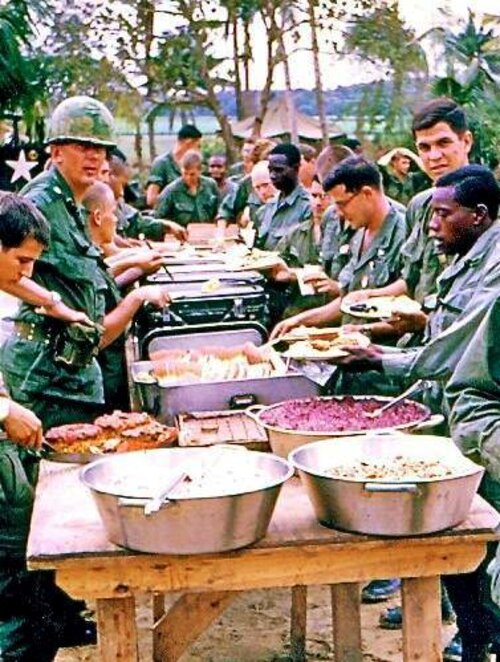
1967 Christmas Dinner at LZ English
I have always said the American military will move Heaven and Earth to get their men a Christmas dinner. I suspect this is uniquely American. In the Korean War, the Americans up north by the Chosen Reservoir got turkey, even if it was ice cold. In the Vietnam War picture above, members of the 1st Cavalry Division have been pulled out of the field by helicopters and flown to Landing Zone English for a break and a Christmas dinner. The picture was taken by Chaplain Phil Lucid.
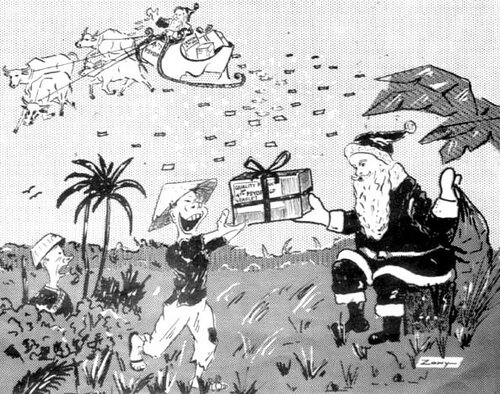
Christmas Cartoon published in the 4th PSYOP Group's Newsletter
CREDIBILIS, Vol II, No.12, December 10 1967, Saigon Vietnam
When you talk about Christmas in Vietnam you must remember that it was a more cynical time with an unpopular draft and the GIs were looking at a one-year tour and anxiously waiting to return home. A sign of the times might be the song “Jingle Bells” as sung by troops. I am sure there are many more stanzas but these are the ones I recall:
Jingle bells
Mortar shells
VC in the grass
Take your Merry Christmas and jam it up your ass!
Jingle bells
Mortar Shells
Charlie’s in the wire
Take your Merry Christmas and set your ass on fire!
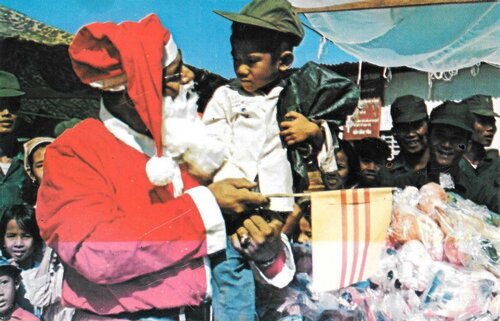
Thank You, Santa!
The Republic of Vietnam General Political Warfare Department was responsible for developing and implementing PSYOP programs within the Republic of Vietnam Armed Forces to create and maintain the loyalty of the RVNAF to its leaders, nation and national ideology; gain and maintain the support of the civilian populace; and break down the loyalty of the Viet Cong and cause him to desert the enemy and rally to the government side. The picture was taken by Tran Buu Khanh. He was a Vietnamese Army enlisted man and combat photographer and part of General Political Warfare Directorate's still photo lab. The picture was also used in a full color calendar page showing quality of life scenes to boost military and public morale.
The photograph above depicts Santa Claus, who looks suspiciously like a black American soldier, holding the flag of the Republic of Vietnam and a young Vietnamese child. In the background you can see ARVN soldiers and their children and bags of gifts and fruit which will certainly be given to the children.

The PSYOP-POLWAR Newsletter
The PSYOP Newsletter was printed by the United States Military Assistance Command to inform commanders, PSYOP personnel, and PSYWAR advisors of psychological operations in Vietnam and to exchange ideas and lessons learned. Later Vietnamese POLWAR personnel were added and the name was changed to the PSYOP-POLWAR Newsletter. Looking through my copy from December 1967 I find the following comment:
CHRISTMAS CHIEU HOI APPEALS: JUSPAO has produced two tapes directed at the Viet Cong during the Christmas season. Although most of the target audience is not Christian, most of them know about Christmas. They do not associate with it all the religious meaning felt by Christians, but they do tend to recognize it as a time of gift-giving and general good will. The Vietnamese have also adapted Christmas carols such as “Silent Night” and “Little Town of Bethlehem” to the Vietnamese language and these tunes should be recognized by the target audience. Tape 123, “Return on the Occasion of Christmas” with background music of “Little Town of Bethlehem” and tape 124, “”Enjoy a happy reunion with your family at Christmas with background music of “Silent Night,” have been produced for the Christmas Season. These tapes should be used between 18 and 28 December 1967.
Christmas in the U.S. 4th Infantry Division
Americans love everything about Christmas. Especially playing Santa. Here, Soldiers from the Echo Co 2/35, 4th Inf. Div. celebrate Christmas in the Central Highlands of Vietnam on Christmas Day, 1969. Shaving cream was applied to create beards and a mail bag was cut up to provide the Santa caps. Check the guy keeping watch in the tree in the background. The photo is believed taken by David Arness.
During the Vietnam War, the Democratic Republic of Viet Nam (DRVN) produced a number of Christmas cards for use against American troops. These were usually disguised as National Liberation Front or Viet Cong products, but they were of excellent quality and certainly produced in the North. Many of the cards are small, and meant to be folded and placed in a wallet.
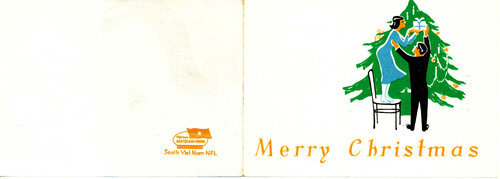
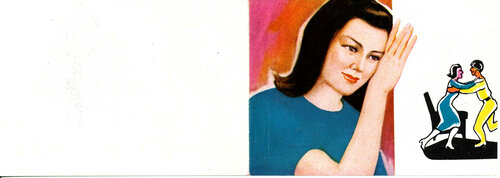
1. A small folded card depicts a man and wife on the outside front decorating a tree with the text "Merry Christmas." The outside back is blank except for a small vignette at the lower right with the Viet Cong flag and the attribution "South Viet Nam NLF" in both English and Vietnamese. Inside, the left side is blank; the right side shows a woman pensively imagining a reunion with her soldier husband. When folded this card is 97 x 70 mm.
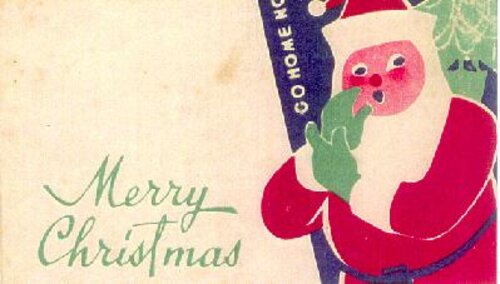
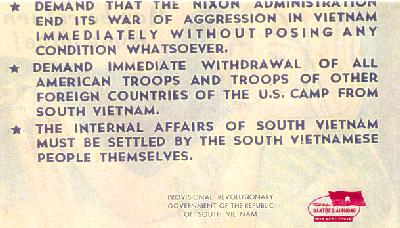
2. A small folded card depicting Santa Claus at right, with the words "Merry Christmas" to his left. The back of the card has a long message reading "Demand that the Nixon administration end its war of aggression in Vietnam immediately without posing any condition whatsoever. Demand the immediate withdrawal of all American troops and troops of other foreign countries of the U.S. camp from South Vietnam. The internal affairs of South Vietnam must be settled by the South Vietnamese people themselves." Beneath the text is a red Communist flag with star, and the text "Provisional Revolutionary Government of the Republic of South Vietnam." When unfolded the card is blank at left. At right a woman is shown looking at a photo of her husband. The first word or two cannot be read, but the text ends "home alive!" When folded this card measures 105 x 60 mm.


3. A small folded card 110 x 65 mm in size depicts Santa Claus in a red costume at right, with the words "Merry Christmas" vertically along the right margin. The back of the card has an olive-colored sky, two snow-covered pine trees, and snow-covered ground. At lower left is the flag of the Viet Cong and the text "South Viet Nam NLF". Spilling from Santa's bag are several leaflets reading, "End the war!" and "Get out now!" When unfolded, a message at left on a white background says: "There is an empty place at the Christmas table at your family (sic)." At the right, a wife is sitting alone at a dinner table in front of a decorated Christmas tree. This leaflet was found in 1970 in the demilitarized zone at the North Vietnam border by a Private First Class of the “Black Knights,” 3rd Squadron of the 5th Armored Cavalry. The unit arrived in Vietnam on 2 February 1967 and departed Vietnam on 8 November 1971. The finder said:
The North Vietnamese had spread these through the jungle along the DMZ. I saw these leaflets on the ground and at first thought they might be booby-trapped. I was on a mission near the DMZ past Dong Ha and Alpha-4, the northernmost U.S. Army outpost in South Vietnam.
4. This card is known only from a printed description. It depicts a man and wife decorating a tree with "Merry Christmas" on front, and text that begins "How democracy operates…" and ends "Go home" on back. It was produced by the NLF.

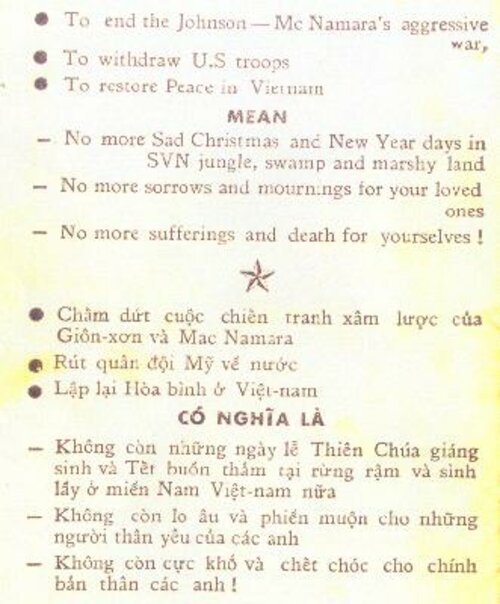
5. This is a standard-sized card that measures 134 x 162 mm. The front depicts a mother and baby, with snow-covered evergreen trees in the background and the text "Christmas and New Year." Inside on the left is an English language message; the same message is written in Vietnamese at the right. The message states, "US Servicemen! Once again, you have to endure Christmas and New Year days in this remote country. Plenty of sufferings and death far from your dear family and your loved ones! Why? Only because of the grave mistake of Johnson's administration to invade Vietnam, involving everyday deeper in the hopeless and endless Asian land war!" The message continues on the outside back, with English text above and Vietnamese text below. The English messages is "To end the Johnson–McNamara aggressive war, to withdraw U.S. troops, to restore peace in Vietnam mean no more sad Christmas, and New Year days in SVN jungle, swamp and marshy land. No more sorrows and mourning for your loved ones. No more sufferings and death for yourselves!


6. This leaflet is an example of a folded leaflet that was designed to fold at the middle and open-out to reveal the inside. The front of the leaflet contains a colored drawing depicting a Santa Claus similar to the picture used in example #2 above with the same greeting of 'Merry Christmas.' When unfolded or opened out, the inside of the leaflet contains a drawing depicting a lonely American female gazing at a photograph of her loved one who is away fighting in Vietnam. The back of the folded leaflet sends the message from the National Liberation Front to American GIs, urging them to demand an end to the war. The pictures were designed to elicit strong emotions of homesickness from GIs in hopes of affecting their ability to concentrate on the battlefield.
Larry Davis, who served with E Company, 2/501st Infantry, of the 101st Airborne Division saw this leaflet in the field. This is one of the rare cases where a solder mentions a specific leaflet. He said in part on the Website Vietnam Vets Only:
On December 19th approximately 30 Viet Cong took over a village and began an intense incoming barrage of mortar fire, RPG's and light weapon fire. I persuaded the Captain to take platoon to confront them in the village. 7 Viet Cong were killed, 16 ARVN's were wounded and one KIA. Those 7 dead Viet Cong had hundreds of propaganda pamphlets. I picked one of the pamphlets up and kept it these last 50 years.
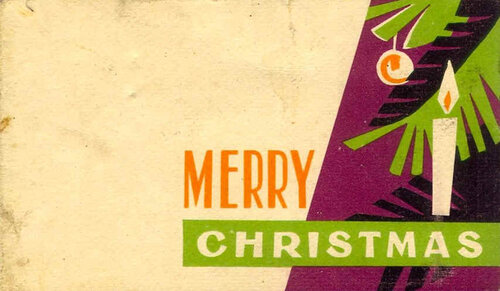
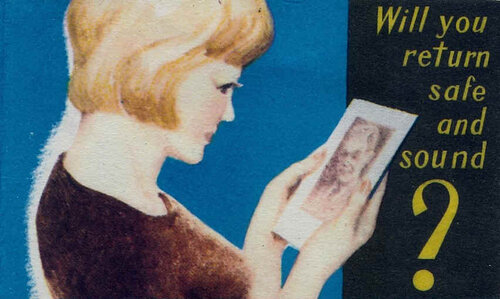
7. Another small folded leaflet in the form of a Christmas card. The front depicts a small section of a decorated Christmas tree and the words “Merry Christmas. The back depicts a wife looking at a photograph of her husband with the text, "Will you return safe and sound? The leaflet was found in Bong Son about Christmas 1967.
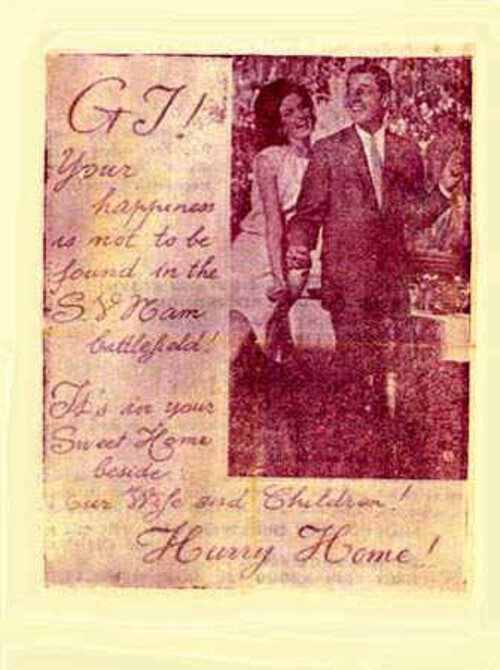
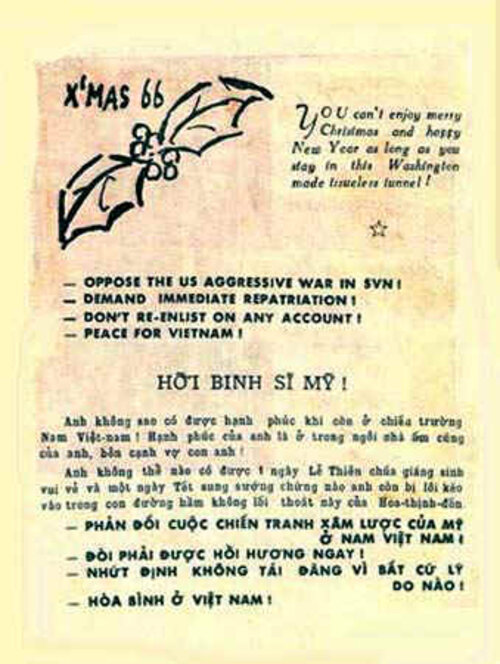
Although not a Christmas card, this Viet Cong leaflet uses the theme of Christmas. The front depicts a happy husband and wife in front of a Christmas tree and the text:
GI! Your happiness is not to be found in the South Vietnam battlefield!
It’s in your sweet home beside your wife and children!
Hurry home!
The back depicts what apparently are mistletoe and the text:
X’MAS 66. You don’t enjoy merry Christmas and happy New Year as long as you stay in this Washington made issueless tunnel.
Oppose the aggressive war in South Vietnam!
Demand immediate repatriation!
Don’t re-enlist on any account!
Peace for Vietnam!
Viet Cong Propaganda leaflets that use Christmas as a Theme
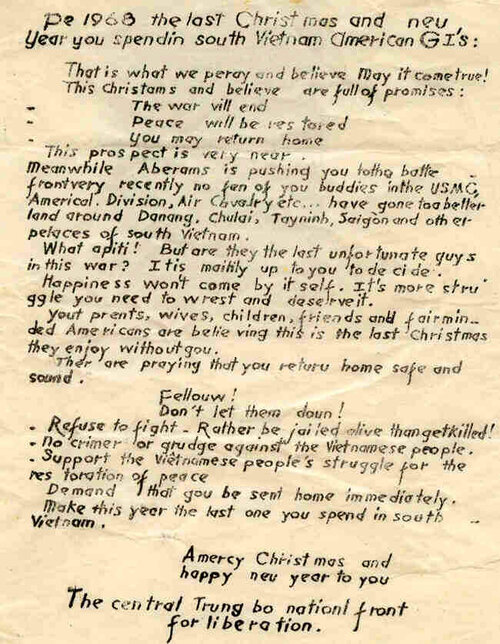
Christmas 1968
Although I have tried to keep this article composed of propaganda in the form of a Christmas card, often the holiday is just used as part of the propaganda text in the hope that it will demoralize the soldier and make him think of home. The United States printed sentimental leaflets mentioning the Vietnamese holiday "Tet," and the Viet Cong printed nostalgic leaflets that mentioned Christmas. The following two leaflets were found at the site of a small Viet Cong base camp by members of the 23rd Infantry Division in January, 1970.
The poorly written and spelled leaflet from the Trung Bo National Front for Liberation above talks of Christmas 1968 and mentions that parents, wives, children and friends are praying for the safe return of the soldiers. It ends:
Make this year the last one you spend in Vietnam. A Merry Christmas and a Happy New Year to you.

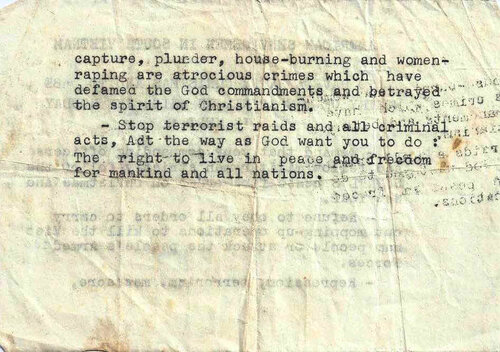
Another Christmas 1968
This leaflet was found before Christmas 1968, around “Dodge City” and is in the collection of former United States Marine Bob Bowen. Notice that they insist that Americans follow the cease fire, though the VC are about to break it as part of the 1968 Tet uprising.
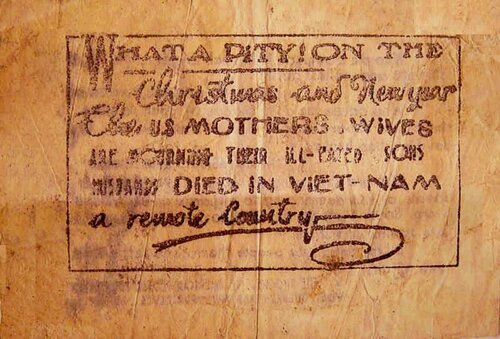
What a Pity!
This discolored and poorly written leaflet says on one side:
What a pity! On the Christmas and New Year the U.S mothers, wives are mourning their ill-fated sons husbands died in Viet-Nam a remote country.
The other side continues in part:
Who pin down you in this hell to get a full hard ship life and useless death. Nixon, Laird, Abrams, Bunker are!
Who cause the cosysences of your families have been separated and a great many dream, like love parties broken? Nixon, Laird, Abrams, Bunker are!
Who are struggling for defense of the highest ideals, of U.S.A demanding to withdraw all U.S troops from South Vietnam to save thousands of U.S youths are survival in Vietnam….
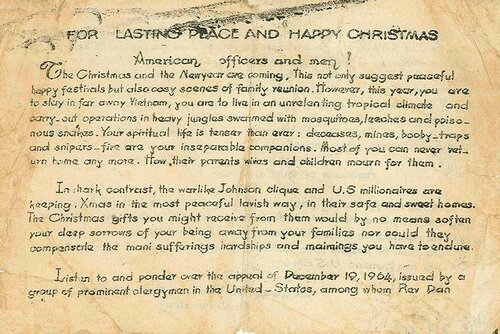
For Lasting Peace and Happy Christmas
Courtesy of Dr. Nicolas Gessler
This leaflet is printed on both sides and was found in Que Son Valley in March 1968. It calls for the Americans to make peace during the holiday season. It attacks the U.S. government with such comments as:
The Christmas and the New Year are coming. This not only suggest peaceful happy festivals but also cosy scenes of family reunion. However, this year you are to stay in far away Vietnam, you are to live in unrelenting tropical climate and carry out operations in heavy jungle swarmed with mosquitoes, leeches and poisonous snakes…
In stark contrast, the warlike Johnson clique and U.S. Millionaires are keeping Xmas in the most peaceful lavish way, in their sweet homes.
The leaflet is signed by the “Quang Nam Province National Front for Liberation.”
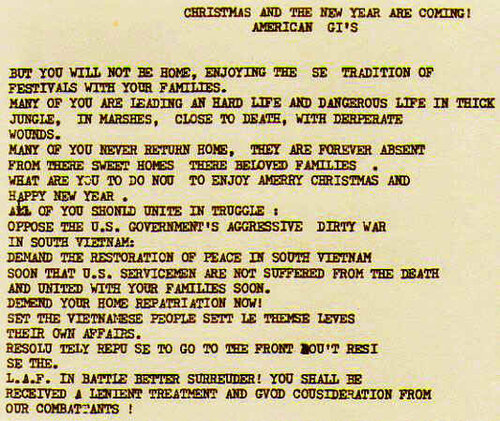
Christmas and New Year are Coming!
Another Communist leaflet that uses Christmas as a theme was spread in the hundreds all around a small U.S. Army platoon compound one night. The text is in English on one side and Vietnamese on the other.
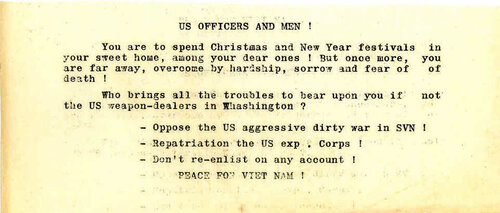
US Officers and Men!
This leaflet reminds American soldiers that once again they are away from home on Christmas because of the evil weapons-dealers in Washington.
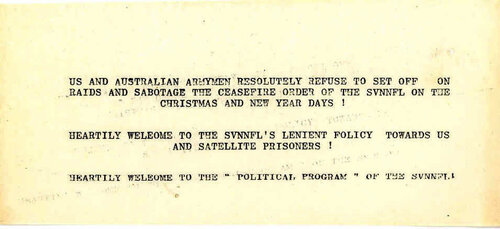
US and Australian Armymen
The leaflet appears to be made by the same Viet Cong propagandist as the one above, but adds the Australians to the mix.
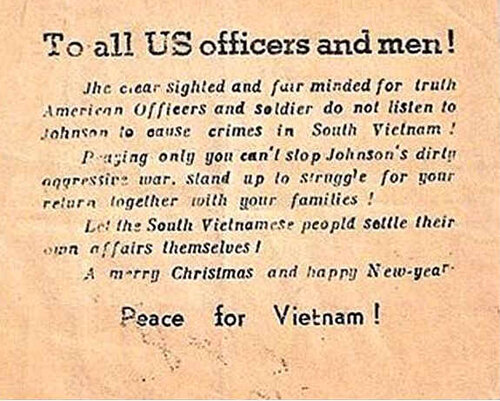
To all U.S. Officers and Men!
The next two leaflets were part of a propaganda peace movement where Vietnamese civilians egged on by Viet Cong sympathizers pleaded with U.S forces not to use artillery near their homes and fields. The leaflets were handed to Second Lieutenant Dan Moore, a United States Marine forward observer by Vietnamese farmers pushing them to the Americans through the wire at Phu Lac, a Marine company combat base about 20 miles southwest of Da Nang.
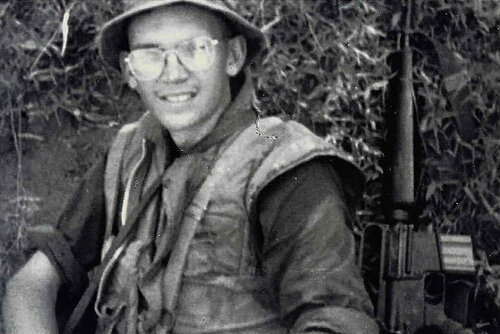
Second Lieutenant Dan Moore
Dan had this to say about the leaflet:
About noon on Christmas Day 1967 we were alerted that a large group of unarmed local Vietnamese villagers, accompanied by what had to be VC organizers, were approaching the base on a dirt road. The crowd stopped outside the wire. We watched the group, shouting slogans in Vietnamese, for about ten minutes. The group leaders handed us a number of small leaflets.
From a letter I sent home from Vietnam on 9 January 1968:
“About 300 people brought to our base propaganda literature along with a Peace Christmas tree. They pleaded for food and protection from artillery fire, which prevented them from working their fields. This is probably true to a considerable degree. The villagers did not speak English or know what the propaganda leaflets contained.”
This leaflet was handed to the American troops about Christmas 1967 and uses a Christmas message and ends with:
A Merry Christmas and a Happy New Year
Peace for Vietnam!

American boys and Girls
This green leaflet (Did the Viet Cong know that Christmas colors are red and green?) was also handed to American troops in the 1967 propaganda operation above. The handwriting is pretty good. I do not believe a Vietnamese wrote the message. I think it more likely a turncoat or a person that lived and was educated in the United States:
American boys and girl receive nice Christmas presents,
While U.S. bombs and shells kill Vietnamese children!
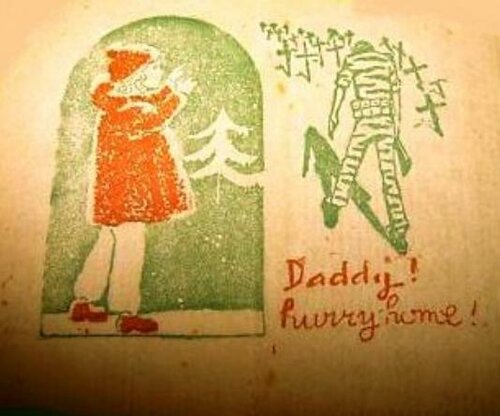
Daddy! Hurry Home!
I am placing this folded Viet Cong leaflet into the Christmas article even though it does not say "Christmas" in the text. The colors are red and green which are Christmas colors, there seems to be a Christmas-type tree behind the little girl, she seems to have snow on her coat, and although her father in a tiger-stripe camouflage uniform could be walking through a field of graves, the crosses are also a Christmas symbol. The image on the front is a little girl at home thinking of her father in Vietnam:
Daddy! Hurry Home!
The leaflet was found by a patrol in the field in 1969 near Tan An in the Mekong Delta. When unfolded, the same message is depicted in both English and Vietnamese. The message in green text is:
AMERICAN GI's!
LBJ and Nixon will both recognize that to avoid their shameful failure there must be an immediate "non-Americanization" of the war in S.V.N.
Why do you still stay in VN to face with hardships and dangers and at last get killed uselessly and senselessly?
Struggle for your home coming now! You loved ones at home are waiting to see you.
GET OUT OF V.N. NOW AND ALIVE!
How interesting that Richard Nixon will later invent the word “Vietnamization” to explain the American partial withdrawal from the war and here the Vietnamese have invented the word “Non-Americanization.”
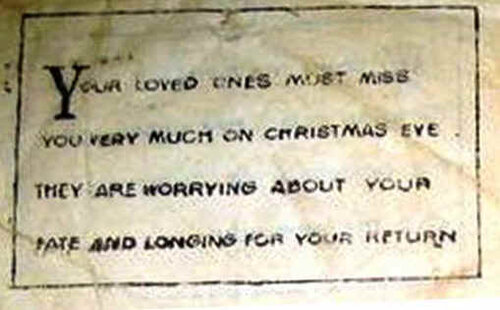
Your loved ones…
Many of the Viet Cong leaflets were printed in the field under the worst conditions on poor quality paper. This leaflet is a case in point. The text is:
Your loved ones must miss you very much on Christmas eve. They are worrying about your fate and longing for your return.
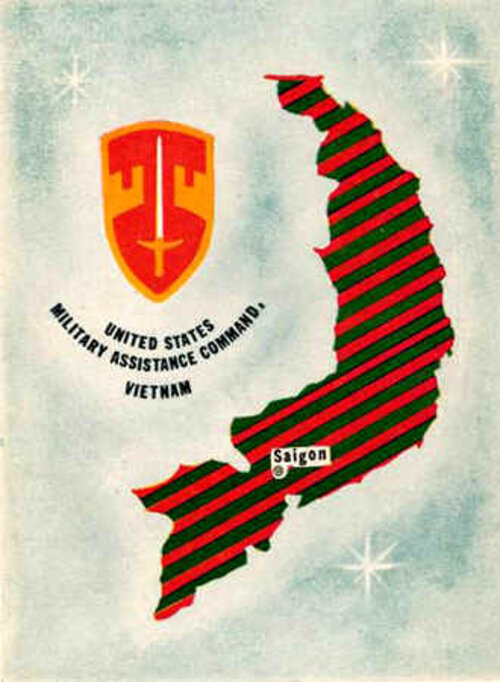
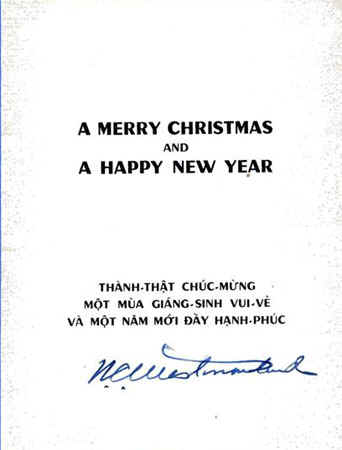
US Military Assistance Command - Vietnam (MAC-V)
Christmas Card sent to author signed by General Westmoreland
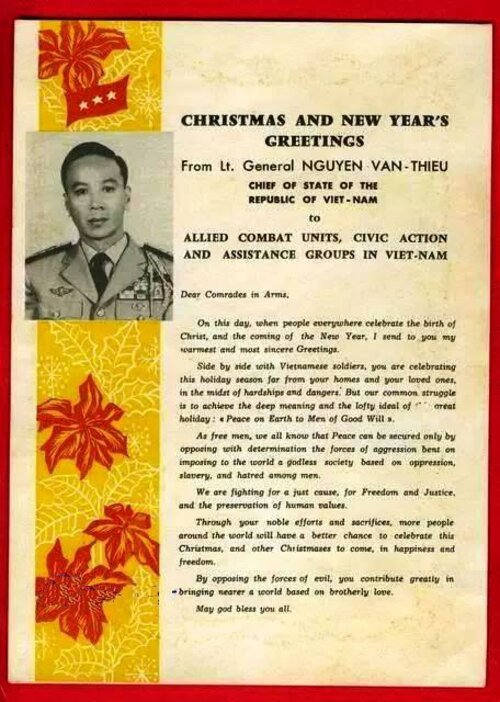
Christmas and New Years Greeting from General Thieu
We opened this section with a stanza of the Vietnam War “Jingle Bells.” Here is a second version:
Jingle bells, mortar shells, VC in the grass,
We’ll get no Merry Christmas until this year has passed,
Jingle bells, mortar shells, VC in the grass,
Take your home-made Christmas tree and shove it up your ass…
Panama - Operation Just Cause
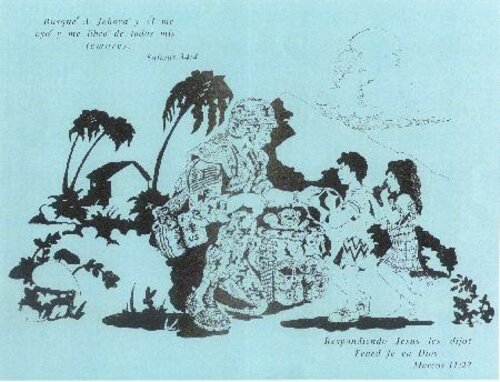
Panama Christmas Card
During the United States intervention in Panama to arrest General Noriega and stop his drug smuggling, the United States Army 4th Psychological Group prepared a leaflet in the form of a Christmas card. Text on the front and back is "Much happiness" and "For all the children of Panama, a merry Christmas and a prosperous new year. From the American armed forces. 1990." The inside shows an American soldier with a bag of toys handing a soccer ball to a young Panamanian boy while a girl stands by awaiting her gift. The text is "And Jesus answered and said to them, Have faith in God. Mark 11:22" and "I sought the Lord, and he heard me and delivered me from all my fears. Psalms 34.4." The latter passage was probably selected as an allusion to the U.S. invasion answering the prayers of the people of Panama for liberation from the despot Noriega.
Operation Desert Storm
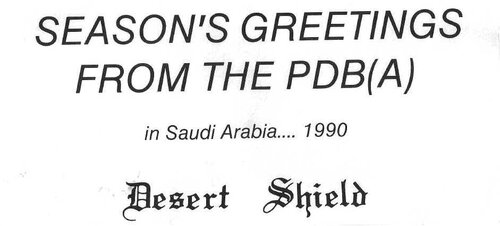
Operation Desert Shield Christmas Card printed by the PSYOP Dissemination Battalion
Because Operation Desert Storm was fought against Iraq over the Christmas holiday season of 1990, there were numerous unofficial Christmas cards prepared by entrepreneurs to be sold in the military Post Exchange Stores in the mid-east. For instance, the U. S. Allegiance Company stationery box contained 3 sheets of patriotic letterhead, 6 postcards, and 12 greeting cards. The American Greeting Card Company prepared a set of 12 Operation Desert Shield greeting cards. The Freedom Greetings Company printed a set of four greeting cards. A company called Two Vets Distributors Inc. offered two large patriotic greeting cards. None of these were officially sanctioned. They were all commercially made for profit. There was one official card which we show above. It was prepared by the U.S. Army’s Psychological Dissemination Battalion based at King Fahd International Airport in Saudi Arabia. The cards, bearing Santa’s sleigh being pulled by camels contained a military parody of The Night before Christmas and was issued to soldiers of the Psychological Operations Task Force. Other official Christmas cards printed by Army units and issued to the troops include the 3rd Armored Cavalry, the 5th Special Forces Group, the 24th Infantry Division and 82nd Airborne Division.
Operation Desert Shield Christmas Card for the 5th Special Forces Group
The above Christmas cards were designed, printed and distributed to members of the 5th Special Forces Group (Airborne) during their deployment to Saudi Arabia during operation Desert Shield. A member of the 5th Special Forces Group designed these cards. It wasn't until well after the cards were printed by a Saudi printing company and distributed did they realize that the word "shield" was misspelled. Notice that in the absence of snow the snowman is made from official olive-drab sandbags. For those that don’t know military tools, the right arm is an Army entrenching tool, a folding shovel easy to carry in a knapsack that can be used as a defensive weapon in the most dire straits. The snowman wears a desert “boonie hat.” On the second card the Special Forces motto To liberate the oppressed, is depicted on their insignia in Latin.
Operation Desert Shield Christmas Card for the 24th Infantry Division
Operation Desert Shield Christmas Card for the 82nd Airborne Division
The “Hootch” is all lit up and sand from a sandbag makes the design. Notice the “AA” design – All American
Because Operation Desert Storm was fought against Iraq over the Christmas holiday season of 1990, there were numerous unofficial Christmas cards prepared by entrepreneurs to be sold in the military Post Exchange Stores in the mid-east. For instance, the U. S. Allegiance Company stationery box contained 3 sheets of patriotic letterhead, 6 postcards, and 12 greeting cards. The American Greeting Card Company prepared a set of 12 Operation Desert Shield greeting cards. The Freedom Greetings Company printed a set of four greeting cards. A company called Two Vets Distributors Inc. offered two large patriotic greeting cards. None of these were officially sanctioned. They were all commercially made for profit. There was one official card which we show above. It was prepared by the U.S. Army’s Psychological Dissemination Battalion based at King Fahd International Airport in Saudi Arabia. The cards, bearing Santa’s sleigh being pulled by camels contained a military parody of The Night before Christmas and was issued to soldiers of the Psychological Operations Task Force.
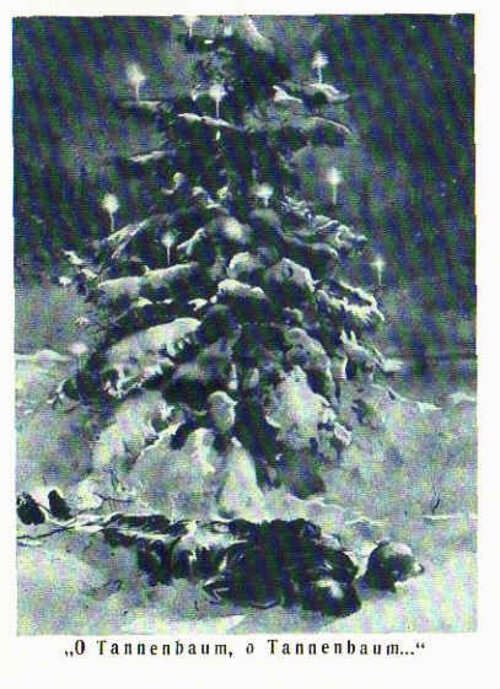
Christmas Tree PSYOP
O Tannenbaum, O Tannenbaum (“O Christmas Tree...”)
The card depicts a German soldier frozen to death on the Eastern front beneath a decorated fir tree. The Russian postcards were imprinted on the address side with a 6 pfennig Hindenburg stamp and the word Postkarte. To the left of the stamp is an imitated express label Des Führers WeihnachtsÂbescherung (“The Fuhrer's Christmas Present”). 500,000 of each card were printed in Moscow on 10 December 1941.
One normally would not expect a Christmas tree to be an object of psychological operations, although during WWII they were used numerous times in propaganda leaflets as the Russians depicted dead Germans in the snow beneath them. The tree itself, although probably of pagan origin, is a symbol of Christianity today and since few of the battles going on around the world are based on the superiority of Christians over non-Christians, the tree would seem to be a weak PSYOP image. Having said that, reports still appear of its use in campaigns, whether official of unofficial. Two such reports appeared in December, 2010.
Colombia - Operation Christmas
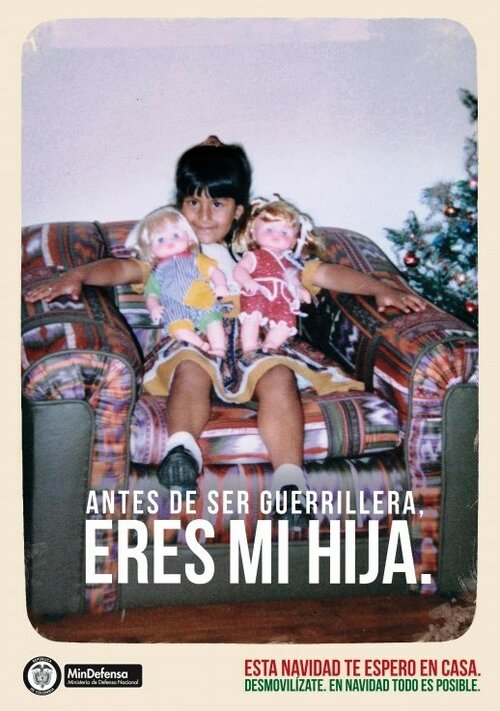
Colombian Ministry of Defense Poster
Before you became a Guerrilla you were my daughter
I hope you will be home this Christmas
Demobilize. Everything is possible at Christmas
The first story is out of Colombia where their army installed a giant Christmas tree in rebel territory to encourage guerrilla fighters to demobilize. Colombian Special Forces soldiers infiltrated the remote Macarena mountain range to dress an 82-foot high tree with 2,000 lights. When guerrillas approached the tree, movement sensors made it light up and a banner announced the following message:
If Christmas can come to the jungle, you can come home. Demobilize. Everything is possible at Christmas.
The army says it will put up trees in nine other rebel-held zones to spread the message that Christmas is a good time to abandon armed struggle. “Operation Christmas” was carried out by elite troops using Blackhawk helicopters. As well as lights, the tree was decorated with slogans saying “Demobilize, at Christmas everything is possible” and “If Christmas can come to the jungle, you can come home.” A commercial made by the military shows the soldiers, dressed in camouflage uniforms and face paint, wrapping 2,000 lights around the branches and trunk. A Colombian military spokesman said, “For us, the most important month is December. Many make the final decision about demobilizing this month.”
Traditionally, the holiday season sees a larger number of defections as rebels reflect on being away from home and loved ones. Colombian President Juan Manuel Santos said that rebel leaders tell their followers that they will be killed if they turn themselves in, but the Christmas trees give another message, he said. The first year that this campaign was used 331 Guerrillas turned themselves in.
In the second report, as South Korea played military war games off the coast of North Korea, a church illuminated a huge steel Christmas tree standing atop a South Korean peak that overlooked North Korean border towns. The tree had been lit in the past and the North had warned that it could trigger bloodshed on the peninsula. The rival Koreas have fought a propaganda war, using leaflets, loudspeakers and radio broadcasts across the border almost since the end of the Korean War. South Korea halted the propaganda campaign several years ago, including the Christmas tree lighting, as ties between the North and South warmed. Recently the North has become belligerent, sinking a South Korean Navy vessel and firing on a South Korean island and things are suddenly hot again. The church had sought government permission to light the tree over the years, but had been denied until this year.
Thanksgiving
This article is about the theme of Christmas in psychological warfare. My partner Major Ed Rouse suggested that we mention the holiday of Thanksgiving as well. Unlike Christmas, the holiday of Thanksgiving has not been used very much as propaganda because it is uniquely American and not something practiced in other countries. However, we do rarely see printed matter that mentions this holiday.
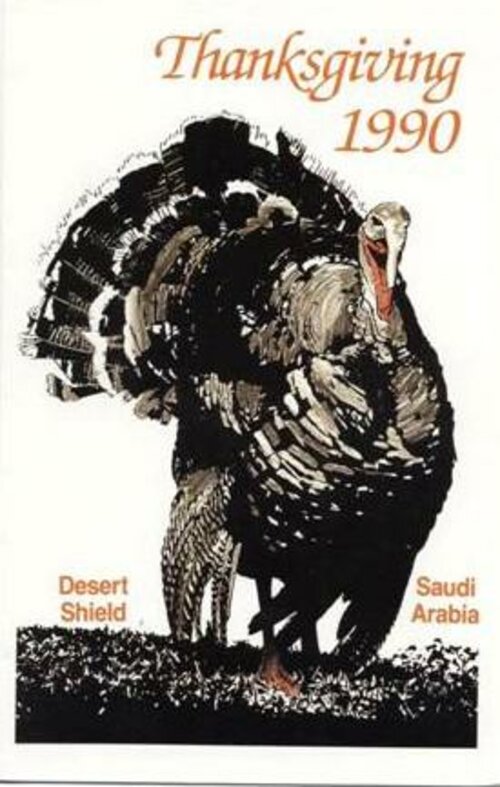
Above, the 101st Airborne Division in the Persian Gulf celebrated the 1990 Thanksgiving holiday with special meals and commemorative menus while they awaited the order to commence Operation Desert Storm. The menus were in full color on heavy cardboard. Inside, besides telling the soldier what he will be fed on that day, both cards contain a personal letter from Major General J. H. Binford Peay III, their division commander. He says in part:
I could not be more proud of this soldier team and the work you have done preparing for the tough days ahead. My prayers and best wishes are with each of you on this special day.
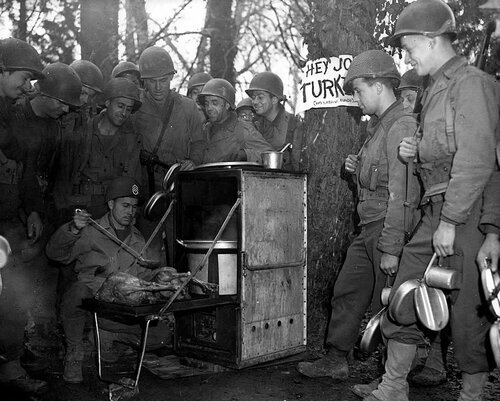
WWII American Troops get their Thanksgiving Turkey in the Field
Because Thanksgiving is so uniquely American, no matter where he is, in the jungle or in the desert, every effort is made by the military to make that day special for the troops. On Thanksgiving Day, every headquarters will move Heaven and earth to get turkey, stuffing and even peanuts and candy to the soldiers in the field. If you were eating K-rations, C-rations, or MREs all year, you knew that on Thanksgiving Day the Army would somehow find a way to get turkey to you.
This has been a brief review of the use of Christmas themes in wartime propaganda. I am sure there are many more such items in the hands of wartime veterans. If you have further information on this subject kindly contact the author at sgmbert@hotmail.com.